![]()
![]()
![]()
Use LEFT and RIGHT arrow keys to navigate between flashcards;
Use UP and DOWN arrow keys to flip the card;
H to show hint;
A reads text to speech;
333 Cards in this Set
- Front
- Back
|
Initial approach to every trauma situation |
A: ABCDE A: C-spine immobilization and x-ray |
|
|
How to clear c-spine clinically? |
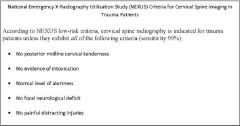
A: |
|
|
Etiology and treatment of Cauliflower ear |
A: Subperichondrial hematoma formation, will devascularize cartilage, leads to neocartilage formation and distortion of ear shape A: Treatment – Incision & drainage of hematoma, reduction of neocartilage formation, pressure dressing application for 7-10 days |
|
|
Five factors to consider when repairing the auricle after a total avulsion |
A: Status of the Avulsed portion – Size, viability? A: Status of the Remaining tissue – May need healing to occur prior to reconstruction, stenting of EAC A: Timing of repair – Delay several days with Abx if wound contaminated (>24 hours after laceration, or >5 hours after animal/human bites) A: Best Use of Remaining tissues – Absorbable sutures for perichondrium, non-absorbable sutures for skin A: Careful Planning of reconstruction – selection of technique |
|
|
Five options for repairing the auricle after a total avulsion |
A: Baudet technique = Reattachment of auricle after fenestration of cartilage at 1 cm intervals A: Pocket principle = Dermabrasion, postauricular pocket for 2-3 weeks, and lateral surface is released A: Temporoparietal flap A: Microvascular Re-implantation if vessels are adequate 3: If unsalvageable, can opt for Osseointegrated Prosthesis; possible role for HBO |
|
|
Four Symptoms of laryngeal trauma |
A: Hoarseness A: Pain A: Dyspnea A: Dysphagia |
|
|
Ten Signs of laryngeal trauma |
A: Stridor A: Hemoptysis A: Subcutaneous emphysema A: Loss of thyroid cartilage eminence A: Laryngeal tenderness A: Palpable deformity A: Vocal fold immobility A: Laryngeal hematoma A: Laryngeal edema A: Laryngeal lacerations |
|
|
Schaefer - Fuhrman laryngotracheal Injury classification (5) |
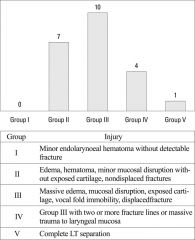
A: An external file that holds a picture, illustration, etc. *Also group IV could have AC involvement |
|
|
Six conditions fit for Medical management of traumatic laryngeal injuries |
A: Edema A: Small hematoma formation A: Nondisplaced single stable fracture A: Lacerations with no cartilage exposure A: Healthy vocal cord movement A: No injury to anterior commissure |
|
|
Medical management for laryngeal trauma |
A: Observation x 24h, A: Voice rest A: Humidification A: HOB elevated A: Systemic steroids A: Reflux precautions A: Antibiotics (especially if mucosal disruption) A: Possible NG if mucosal damage |
|
|
Eight indications for Open repair of traumatic laryngeal injuries |
A: Mucosal lacerations that are large, or involving the anterior commissure, or free edge of the vocal cord A: Exposed cartilage A: Multiple or displaced fractures of cricoid and/or thyroid A: Vocal cord immobility or disruption of the cricoarytenoid joint A: Airway compromise requiring intubation/tracheotomy A: Active bleeding or hemoptysis A: Concordant injury to neck requiring surgical exploration A: Air escaping through the neck wound |
|
|
Surgical treatment of laryngeal trauma (3 general categories) |
A: Endoscopy A: Open exploration A: Open exploration with Stenting 3: Open can be via midline laryngofissure/thyrotomy or anterior cricoid split |
|
|
Four indications for Stenting in laryngeal trauma (1-3 weeks) |
A: Anterior commissure involvement A: Multiple displaced laryngeal fractures A: Multiple severe endolaryngeal lacerations A: Architecture of larynx not maintained by open fracture fixation (loss of cartilaginous framework) |
|
|
Management Algorithm for laryngeal trauma |
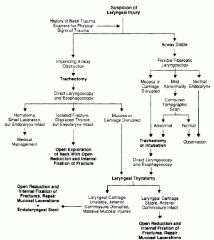
A: If airway is unstable – Tracheostomy, direct laryngoscopy and esophagoscopy A: If airway is stable – Flexible fiberoptic laryngoscopy and CT scan A: If single nondisplaced fracture or small laceration without cartilage exposure – Medical management A: If displaced fracture but no exposed cartilage/endolaryngeal disruption – ORIF without thyrotomy A: If displaced fracture with exposed cartilage/endolaryngeal disruption – Laryngeal thyrotomy without stent A: If AC involved, or multiple severe lacerations, or multiple fractures, or unstable cartilage – Laryngeal thyrotomy with Stent * Schaefer’s algorithm (1991) |
|
|
Fix facial nerve proximal to what line? |
A: Vertical line running through lateral canthus and through mental foramen |
|
|
Strategies for fixing the traumatized facial nerve |
A: Distal excitability lost after ~72 hours, ideal to fix before then; if primary repair impossible, clip/tag ends for future repair A: Reapproximation done with 8-0 to 10-0 monofilament suture under microscopy |
|
|
Three types of facial nerve repair |
A: Epineural A: Perineural A: Interfascicular |
|
|
What anatomic landmark determines likelihood of parotid duct trauma? |

A: Vertical lacerations anterior to posterior border of masseter muscle likely to injure the parotid duct A: The duct exits the parotid abutting masseter then runs in a line drawn between tragus and the midportion of the upper lip, coursing along with the buccal branch of the facial nerve *Parotid duct line |
|
|
What are the hallmark signs of parotid duct injury? |
A: loss of upper lip elevation along with saliva pooling in the wound |
|
|
Parotid duct injuries classification and general management (emedicine)? |
Site A: Posterior to the masseter or intraglandular → Ligate duct Site B: Overlying the masseter → repair over stent or ligate proximal end if not enough length to reapproximate Site C: Anterior to the masseter → if not enough length to reimplant or repair then ligate, if good length and papilla uninjured then reimplant proximal portion into papilla with dilatation of papilla, if good length & papilla injured then reimplant into buccal mucosa posterior to papilla |
|
|
Q: Three methods of repairing the parotid duct |
A: Ideal – Soft polymeric silicone or polyethylene 22G catheter threaded through Stensen’s duct, Repair of duct with 6-0 or 7-0 monofilament suture under the microscope, suture the stent to the buccal mucosa for 10-14 days A: Less ideal – Tying off the duct, gland atrophies after a period of swelling, pain, possibly infection A: Technically more difficult – Rerouting more proximally in the oral cavity |
|
|
Management of sialoceles secondary to parotid parenchymal injury? |
A: Mostly resolve with conservative measures: Needle aspiration & compression dressing (fluid maybe sent for amylase) Broad spectrum Abx Anticholinergics: scopolamine, glycopyrrolate, TCA Botox injection NPO and TPN A: If chronic: parotidectomy, tympanic neurectomy, low dose RT |
|
|
Management of eyelid laceration defects? |
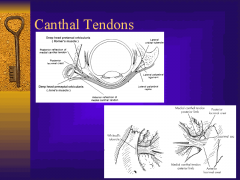
A: <25% loss → Primary closure A: 25-30% → Lateral canthotomy provides 5-10 mm of length and prevents ectropion upon primary closure A: 30-50% → Tenzel rotation flap for both upper and lower Upper eyelid: Sliding tarsoconjunctival flap for lateral or medial defects A: > 50% → Lower eyelid: Tarsoconjunctival bridge flap (modified Hughes procedure→ upper to lower eyelid) or Mustarde rotational Cheek Flap Upper eyelid: Cutler-Beard flap (bridge flap) → lower eyelid to upper eyelid Free tarsoconjunctival graft from contralateral eyelid and a skin graft or local musculocutaneous flap is used for coverage Others: regional flaps for upper lid(nasal or temporal), STSG for the upper lid and FTSG for the lower lidCheck http://www.utmb.edu/otoref/grnds/Eyelid-021218/Eyelid-021218-slides.pdf for pics |
|
|
List degrees of burn depth? |
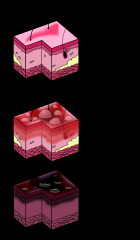
A: First Degree (superficial): Only epidermis, Painful and red, No scarring and heals in few days A: Second Degree (partial thickness): Into dermis, Pain (severe), erythema, blistering, re-epithelialize spont from preserved adnexal structures, usually minimal scarring and heals in few weeks, may need debridement & skin grafting if deep A: Third Degree (full-thickness): Through dermis into subcut, destroying adnexal structures + vessels + nerves, white/gray leathery appearance, no bleeding or pain on prick, No blistering, heals by secondary intention, eschar & hypertrophic scars form, needs debridement & skin grafting A: Fourth Degree: Extends into deep structures (muscles, bone, ligaments), requiring debridement and reconstruction. |
|
|
How to calculate TBSA involved in burn? (Rule of 9s) |
Head and each arm = 9% Back and chest each = 18% Each leg = 18% Perineum = 1% |
|
|
How to calculate amount of fluid resuscitation in burns? |
A: Parkland’s formula: Amount of fluid required in 24 hours of RL (ml) = 4 × Patient's weight (kg) × Percent body surface area (BSA) involved in burns A: The first half is delivered in the first 8 hours, and the remaining half is delivered in the remaining 16 hours A: Children receive maintenance fluid in addition, at an hourly rate of:4ml/kg for the first 10kg of body weight plus;2ml/kg for the second 10kg of body weight plus;1ml/kg for >20kg of body weight. |
|
|
Burns of the mouth |
A: Prolonged wait to allow Demarcation (10-14d)A: Excision after demarcated 3: Contracture a long-term complication, leads to microstomia, prevent by fitting an oral applicance; possible repair with Estlander flap depending on tissue loss |
|
|
List mandible depressors and elevators? |
A: Depressors: geniohyoid mylohyoid anterior digastric platysma lateral pterygoid (?inferior belly) A: Elevators: masseter temporalis medial pterigoid lateral pterygoid (?superior belly) |
|
|
Three areas of inherent mandible weakness |
A: Condylar neck A: 3rd molar region (angle) A: Mental foramen (parasymphyseal) 3: These are the 3 most common mandibular fractures in order of occurrence |
|
|
Describe the adult FDI tooth numbering system? |
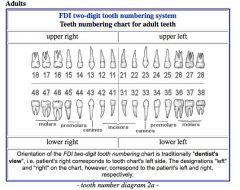
A: Total 32 teeth |
|
|
Define dental terms (cusp, groove, mesial, distal, lingual & buccal)? |
A: Cusps: tooth eminence, Groove: area between cuspsA: Mesial: towards the incisor, Distal: towards posterior mandible or maxilla A: Lingual: towards the tongue, buccal: towards the cheek |
|
|
Angle’s classification of teeth occlusion |
A: Defines position of maxillary 1st molar mesial buccal cusp’s relation to buccal groove of mandibular 1st molar; only describes anteroposterior dental relationships A: Type I – Normal occlusion, cusp fits into groove A: Type II – Retrognathism/overbite, cusp anterior to groove (mesial) A: Type III – Prognathism/underbite, cusp posterior to groove (distal) |
|
|
Define the normal transverse dental relationships? |
A: Buccal cusps of mandibular molars should be between the buccal and lingual cusps of the maxillary molars |
|
|
Define the normal anterior dental relationships (overjet & overbite)? |
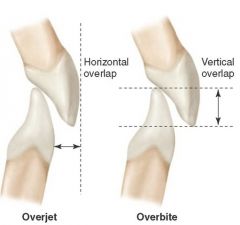
A: Overjet: horizontal anterior overlap/extension of the maxillary incisors forward of the mandibular incisors (should be 1-3 mm) A: Overbite: Vertical overlap of maxillary incisors over mandibular incisiors (also 1-3 mm) |
|
|
Four stages of bone healing |
A: Hemorrhage – 10 days A: Cartilaginous callus formation – 10-20 days A: Hard callus formation – 20-30 days A: Remodeling 3: “He Can Hardly Remember 10 days at a time” |
|
|
Types of bone healing? |
A: Direct or primary bone healing occurs when there is no motion across fracture line (e.g. ORIF) → minimal callus formation to stabilize #A: Indirect or secondary bone healing occurs when there is a gap or significant motion accross fracture line → more callus formation to stabilize site of # with higher chance of malunion or nonunion. |
|
|
What are the benefits of rigid fixation? |
A: Minimal callus development (more callus = cosmetically deforming) A: Minimizes infection A: Allows immediate function (possibly avoiding the need for MMF) |
|
|
Radiographic tests for mandible fractures |
A: Mandibular series – AP, PA, Lateral x 2, Oblique x 2, Townes views A: Panorex A: CT (99% sensitive) |
|
|
Describe Mandible fractures (in general)? (Fling) |
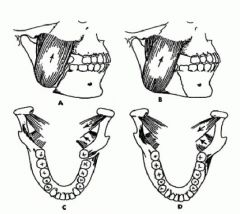
A: Favourable fractures:-managed usually by closed reduction-muscles tend to draw fragments toward each other and reduce the fracture-horizontally (B) and vertically (D) favourable fractures A: Unfavourable when fragments tend to be distracted-usually managed with ORIF-horizontally unfavourable (A):-angle fracture-vector force of masseter and temporalis muscle pulls fragments apart-vertically unfavourable (C):-body and symphysis-parasymphysis areas-vector force of anterior muscles (mylohyoid, digastric) and pterygoid muscles pulls fragments apart 3: Can also be classified as simple vs. compound, displaced vs. nondisplaced, open vs. closed |
|
|
Physical signs of a unilateral condylar/neck (subcondylar) fracture? |
A: Ipsilateral premature contact of molars A: Ipsilateral shortening of vertical ramus A: Deviation of jaw to Ipsilateral side A: Contralateral anterior open bite deformity3: In bil. Condylar/SC fractures will only show symmetric anterior open bite and bilateral Premature contact of molars. |
|
|
what are common patterns of bilateral mandible fractures? |
A: Angle and contralateral body A: Parasymphysis and contralateral subcondylar A: Symphysis and both condyles |
|
|
What is the Kazanjian & Converse classification for mandibular fractures? |
A: Class 1: teeth on both bony fragments A: Class 2: teeth on one bony fragment A: Class 3: no teeth on both fragments |
|
|
General management of mandible fractures |
A: ABCDE/C-spine A: Antibiotics for any case involving teeth bearing segments until gingival or mucosa healed A: Closed reduction (see below for indications)A: ORIF (see below for indications)Classification = Rigid (reconstruction plates, eccentric dynamic compression plates, lag screws), Semirigid (miniplates), Nonrigid (interosseous wiring) ORIF should be done ASAP; if >3 days = MMF and IV antibiotics Rigid and semirigid techniques obviate the need for MMF A: External fixation – Rarely used, when there is a Bone Gap, Contaminated GSW or Infection |
|
|
Indications for Closed Reduction of mandible fractures? |
A: Favorable non-displaced fractures A: Grossly comminuted fractures A: Significant soft tissue loss with inadequate coverageA: Children with developing dentition A: Edentulous mandible with sufficient bone height and/or splint/denture available (e.g. Gunning splints) A: Many types of condylar fractures |
|
|
Contraindications to MMF? |
A: Medical conditions: Alcoholics, Seizure disorder, psychosis, Mental retardation, Nutritional concerns, Poor pulmonary reserve (COPD) A: Non-compliant patients A: Unfavorable fractures |
|
|
Name the methods and duration of MMF? |
A: Arch bars, interdental eyelet wires (Ivy loops), circumferential wiring of dentures or teeth, IMF screws A: duration of fixation: -depends on age and type of injury:-children: 3-4 weeks-adults: 4-6 weeks-elderly: 6-8 weeks-condylar fractures: 2-4 weeks-body and angle fractures: 4-6 weeks |
|
|
List the complications of MMF? |
A: Airway compromise A: Nutritional deficiency A: Aspiration A: Infections A: Dental injury A: TMJ dysfunction or ankylosis A: Malocclusion A: loss of fixation (malunion, nonunion) |
|
|
Indications for mandible ORIF? |
A: Unfavourable and displaced fractures A: Fragment displacement despite closed reduction A: Medical conditions that contraindicate MMF (see above) A: Edentulous patients with severe atrophy or splint/denture not available A: Panfacial fractures that require basis for recon first A: Malunion & Nonunion A: Some condylar fractures (see below) |
|
|
Relative contraindications to mandible ORIF? |
A: Children unless severely displaced or unfavorable A: Severely comminuted # A: Gross infxn A: Healing issues (post RT, transplant, steroids) A: Can be managed with MMFA: Poor bone height |
|
|
List common complications of ORIF? |
A: As MMF (see above) + nerve injury + hardware exposure |
|
|
Describe approaches to perform ORIF of the mandible? |
A: Intraoral Avoids scar and MargM Nerve injury, faster Can reach all areas of mandible (esp. angle and symphyseal & PS) A: External: Adds scar and risk of MargM nerve injury but better visualization of higher fractures and comminuted fractures Submandibular (Ridson), retromandibular, preauricular (risk of facial nerve main trunk inj) |
|
|
Absolute indications for ORIF of Condylar neck fractures by Zide and Kent? (FILMO) |
A: Foreign body in the TMJ A: Inability to establish good occlusion with closed techniques A: Lateral extracapsular condyle displacement A: Condyle displaced into MCF A: Open fracture with potential for fibrosis 3: Relative indications –-bilateral condylar fractures in edentulous patient when splinting is unavailable or impossible because of severe ridge atrophy-unilateral or bilateral condylar fractures when splinting is not recommended for medical reasons or adequate postoperative physiotherapy is impossible-bilateral condylar fractures associated with comminuted midfacial fractures-bilateral condylar fractures associated with marked preinjury malocclusion (gnathologic problem) |
|
|
What are the indications for MMF in condylar #? |
A: Split condylar headA: Intracapsular # A: Severely comminuted condyle A: Risk of devascularization of the condyle with ORIF |
|
|
Eight reasons for Malocclusion after a mandibular fracture |
A: Nonunion A: Malunion A: Subluxation of the condyle A: Unfavorable mandibular fracture A: Tooth impaction in the fracture line A: Undiagnosed second fracture of mandible or maxilla A: Osteomyelitis A: Error in fragment alignment |
|
|
What are the indications for tooth removal in mandibular #? |
A: Tooth in line of fracture interfering with occlusion A: Infected tooth within fracture line A: Fractured tooth, non-viable tooth, exposed pulp |
|
|
Describe the buttress system of the midface |
A: Vertical buttresses (3 paired and 1 unpaired) –NasomaxillaryZygomaticomaxillary (greatest occlusal load)PterygomaxillaryFrontoethmoid- vomerine (single midline) A: Horizontal buttresses (7) –Frontal bar/superior orbital rimsInferior orbital rimsMaxillary alveolus & hard palateZygomatic processes of temporal boneGreater sphenoid wingsMedial and Lateral Pterygoid platesMandible |
|
|
Describe the LeFort fractures
|
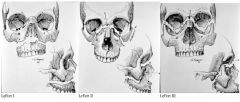
A: LeFort I- Palate-face dysjunction, lower face & maxillae move separately- involves nasal septum, laterally & posteriorly through all maxillary walls to pterygoid plates A: LeFort II- Pyramidal dysjunction, maxillary & nasal regions move separately from rest of midface & skull- involves nasofrontal suture; frontal process of maxilla; lamina papyracea of ethmoid, inf orbit rim and floor, inf orbital foramen, anterior & posterior maxillar wall, zygomaxillary suture, pterygoid plate; and high septum A: LeFort III- Craniofacial dysjunction, includes all the vertical buttresses attaching the midface to the skull base- involves nasofrontal suture; medial and lateral orbital wall and floor; zygomaticofrontal suture; zygoma and zygomatic arch; pterygoid plates and nasal septum3: Three typical patterns, often bilateral, could be mixed; all involved fracture of the pterygoid plates |
|
|
General management of Le Fort fractures? |
A: ABCs, Abx, tetanus A: Reduce fracture (Rowe forceps) A: MMFA: Expose fracture site via multiple approaches A: Plate fractures A: Release MMFA: Check occlusio nA: Elastics/replace MMF 3: If minimal displacement, minor maloclssion or poor surgical candidate → MMF otherwise ORIF |
|
|
Discuss ZMC fractures? |
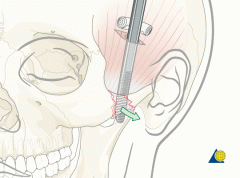
A: Second most common after nasal fractures A: four sutures involved in zygomaticomaxillary complex fractures (“tripod/tetrapod fracture”)-zygomaticofrontal-zygomaticomaxillary-zygomaticotemporal-zygomaticosphenoidA: stabilization requires minimum of two point fixation:-zygomaticofrontal suture-inferior orbital rim-lateral antral wall-zygomatic arch A: procedures usually delayed 5-7 days to allow resolution of edema A: closed reduction:-used if no comminution → Gilles operation +/- transzygomatic Steinmann pin fixation A: open reduction:-used if comminution of lateral antral wall → sublabial incision (Keen) with plating at zygomaticomaxillary buttress-tripod fracture → add transconjuntival incision to access medial orbital rim and lateral brow incision for zygomaticofrontal suture-centrally displaced zygomatic arch → approached via coronal, hemicoronal, or extended pretragal incision * Gillies approach: a temporal incision (2 cm in length), made 2.5 cm superior and anterior to the helix, within the hairline → an instrument is inserted deep to the temporalis fascia and superficial to the temporalis muscle down to zygoma → the Rowe zygomatic elevator is used to apply outward force and reduce the fractured segment |
|
|
Seven bones that make up orbit |
A: Frontal A: Zygomatic A: Maxillary A: Lacrimal A: Ethmoid A: Palatine A: Sphenoid |
|
|
Two theories about Orbital Floor injuries |
A: Hydraulic -force to orbital region → increases intraocular pressure → fractures floor A: Buckling -force on inferior rim → directly fractures floor |
|
|
Seven Common signs & symptoms of orbital blowout fractures |
A: Diplopia A: Inferior rectus entrapment A: Enopthalmos (sunken-in globe) A: Hypesthesia of infraorbital nerve A: Periorbital ecchymosis A: Orbital emphysema A: Decreased visual acuity |
|
|
Indications for surgical repair of orbital blowout fractures |
A: Floor defect ≥2 cm2 or > 50% with Herniation of orbital contents A: Positive forced duction test A: Radiological evidence of extraocular muscle entrapment or diplopia A: Radiological evidence of significant comminution and/or displacement of the orbital rim A: Cosmetically significant enophthalmos ≥2 mm or Hypophthalmos A: Persistent diplopia which failed to improve in 7 or more days 3: ALL pts require assessment by ophtho and need repair within 14 days |
|
|
Seven Indications for Orbital exploration with Zygomaticomaxillary fractures |
A: Persistent diplopia which failed to improve in 7 or more days, positive forced duction testing, and radiologic evidence of perimuscular tissue entrapment A: Cosmetically significant and clinically apparent enopthalmos associated with radiological findings A: Radiological evidence of significant comminution and/or displacement of the orbital rim A: Radiological evidence of significant displacement or comminution of greater than 50% of the orbital floor with herniation of soft tissue into the maxillary sinus A: Combined orbital floor and medial wall defects with soft tissue displacement noted radiologically on CT scans A: Radiological evidence of a fracture or comminution of the body of the zygoma itself as determined by CT A: Physical or radiological evidence of exopthalmos or orbital content impingement caused by displaced periorbital fractures |
|
|
Indications to delay repair of an orbital fracture? |
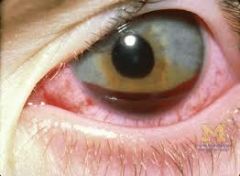
A: Hyphema (see pic) A: Globe rupture A: Significant edema (e.g. post orbital hematoma drainage) A: Only seeing eye |
|
|
Orbital anatomy considerations in facial trauma |
A: No true medial rim A: Maximum diameter ~15 mm posterior to inferior orbital rim A: Maximum height of orbital roof convexity 5 mm A: Maximum depth of orbital floor concavity 3mm |
|
|
What amount of orbital injury will cause Enophthalmos? |
A: Disruption of the orbital floor >2 cm2 A: Bony volume changes >1.5 cm3 (5% of orbital volume) → 1-1.5 mm enophthalmos A: Considerable fat and soft tissue displacement (teardrop sign on Waters view) 3: Enophthalmos greater than 2 mm relative to the contralateral eye creates an observable cosmetic deformity = > 3 cm3 change in bony volume (10%) |
|
|
List approaches to orbital fracture repair? |
A: Endoscopic: Transmaxillary, transnasal A: Transcutaneous: subciliary (preseptal), subtarsal, lynch, medial brow, bicoronal A: Transconjunctival A: Transcaruncular for medial orbit A: Transantral (Caldwell-luc) |
|
|
What materials could be used for recon or orbital wall? |
A: Autogenous materials (eg, bone [cortical and cancellous], cartilage, fascia) A: Alloplastic materials: Nonabsorbable: titanium, silicon, porous polyethylene, and Teflon Absorbable: Polydioxanone, polylactide, and polyglactin A: Allogenic dura (lyodura: freeze dried human dura) |
|
|
List possible complications of orbital floor repair? |
A: Blindness A: Orbital hematoma A: infection/extrusion of hardware/graft A: Ectropion/entropion A: Persistant symptoms: diplopia, enophthalmos |
|
|
Describe the technique for harvesting the outer table of calvarial bone for grafting |
A: Expose the parietal skull A: Outline the area of bone for grafting stripped of periosteum, 2 cm posterior to the coronal and 2 cm lateral to the sagittal sutures A: Use a cutting burr to make a monocortical cut through the outer table; can start with 4 corners and join up with side-cutting burr A: Use a straight osteotome to gently elevate the outer table from the diploic space |
|
|
Symptoms of orbital apex syndrome |
A: Opthalmoplegia, ptosis, pupillary dilation A: Blindness & decreased visual acuity (involves optic nerve) A: Anaesthesia of upper eyelid & forehead |
|
|
What 3 muscles are responsible for (upper) eyelid movements? |
A: Orbicularis oculi – Pretarsal segment most important for blinking, innervated by CN VII A: Levator palpebrae superioris – Innervated by CN III A: Muller’s muscle – Innervated by sympathetics |
|
|
Fracture patterns in nasal trauma |
A: C shaped across cartilaginous septum A: Distal end of nasal bone with C-shaped bony septum A: Midnasal bone with C-shaped bony septum A: Anterior nasal spine A: Multiple or stellate fractures |
|
|
Indications for Closed Reduction of nasal fractures |
A: Unilateral or bilateral nasal bone fracture A: Nasal pyramid deviation <50% nasal bridge width 3: Can use Ashe forceps or Boise elevator |
|
|
Eight indications for Open Reduction of nasal fractures (4 bony and 4 septal) |
A: Extensive fracture/dislocation of nasal bones A: Persistent deformity after closed reduction A: Nasal pyramid deviation >50% of nasal bridge width A: Displaced fracture of the anterior spine A: Dislocation of the caudal septum A: Open septal fracture A: Septal hematoma A: Combined deformity of septal and alar cartilages 3: Avoid plates, use interosseous wires and bone grafts if needed |
|
|
Complications of nasal fractures |
A: Early – Edema, Ecchymosis, Epistaxis, Hematoma, Infection A: Late – Perforation, Saddle nose, Fibrosis/scar/synechiae, Obstruction A: Emergency – CSF leak, Visual impairment, severe Epistaxis, Hematoma in a child, Nasal obstruction in a newborn |
|
|
Components of tears |
A: Lipid layer – from Meibomian glands A: Aqueous portion – from Lacrimal gland A: Mucin – from Goblet cells |
|
|
Anatomy of the suspensory system of the eye |
A: Medial canthal ligament – Anchors eyelid structures to medial wall, maintains configuration of palpebral opening; Anterior horizontal component (strongest, attached to anterior lacrimal crest); Anterior vertical component (attached superior to anterior horizontal component); Posterior horizontal component (weakest attachment, attached to posterior lacrimal crest) A: Lateral canthal ligament – Anchors eyelid structures to lateral wall; attaches to Whitnall’s tubercle, bony spur just inside and above midpoint of lateral orbital rim 3: The suspensory ligament (of Lockwood) forms a hammock stretching below the eyeball between the medial and lateral check ligaments and enclosing the inferior rectus and inferior oblique muscles of the eye. |
|
|
Normal Interpupillary distance |
A: ~60-70 mm |
|
|
Define Telecanthus |
A: Intercanthal distance >1/2 the interpupillary distance (>35 mm) |
|
|
Define Hypertelorism |
A: Abnormal increase in interpupillary distance, usually due to overdevelopment of the lesser wings of the sphenoid |
|
|
Define Pseudohypertelorism |
A: Apparent increase in the interorbital distance due to lateral displacement of the inner canthi |
|
|
Four signs of medial canthal ligament disruption |
A: Telecanthus A: Narrowed & blunted palpebral fissure, with rounding of the medial canthus A: Bowstring sign (lack of canthal resistance or bony movement is +ve) A: Epiphora |
|
|
Six additional signs of an NOE fracture |
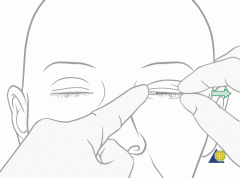
A: Pig nose deformity A: Posterior displacement of nasal bones A: Palpable mobile fracture A: Periorbital swelling A: Epistaxis A: CSF rhinorrheaDiagnosis of NOE fractures * Bowstring sign |
|
|
Reconstruction of NOE fracture/Medial canthal ligament tear |
A: First reconstruct the medial orbital wall A: Repair the MCLA: Lacrimal apparatus – DCR or Conjunctivo-DCR; may reconstructed at a later date |
|
|
Classification of NOE fracture/Medial canthal ligament tear (Markowitz, 1991)? |
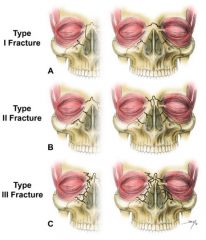
A: Type I– A single, non-comminuted, central fragment without medial canthal tendon disruption- Low velocity injury,- If displaced, reduce fragment transconjunctivally (occ. sublabial, coronal), fixate with micro plates and screws. A: Type II– Comminution of the central fragment, but the medial canthal tendon remains firmly attached to a definable segment of bone.- Medium velocity injury- Realignment & fixation may require transconjunctival, sublabial, or coronal incision, micro plate reduction, and transnasal wiring A: Type III (uncommon)– Severe central fragment comminution with disruption of the medial canthal tendon insertion-High velocity injury- will require microplate fixation with MCL repair, transnasal wiring and bone grafts |
|
|
Describe medial canthal ligament repair |
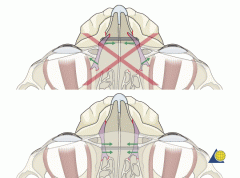
A: Evaluating vectors A: Using transnasal wires to attach ligaments through drill holes to opposite location of NOE or opposite MCL (posterior to posterior lacrimal crest and overcorrect)NOE II, ORIF *Transnasal wiring |
|
|
Classification of frontal sinus fractures |
A: Anterior table A: Posterior table A: Frontal recess 3: Can be any combination, can be displaced or nondisplaced |
|
|
Describe the Gonty classification of frontal sinus fractures |
A: Type I – Anterior table fracture A: Type II – Anterior & Posterior table fracture A: Type III – Posterior table fracture A: Type IV – Through and through fracture with skin |
|
|
Injury to the frontal recess correlates on CT with |
A: Frontal sinus floor fractures 83% of the time A: Anterior ethmoid fractures 67% of the time 3: Thus, if there is an NOE injury or injury to the floor or posterior wall of the frontal sinus, be suspicious of a frontal recess injury |
|
|
Discuss antibiotic prophylaxis in frontal sinus fractures |
A: Aimed at prevention of intracranial sepsis (via foramina of Breschet), should have good CSF penetration A: Give for 2 weeks in compound fractures A: Ceftriaxone or Ceftazidime + Flagyl +/– Ancef offers broad coverage |
|
|
Four signs of frontal sinus fractures |
A: Depressed frontal region A: CSF rhinorrhea A: Supraorbital anesthesia A: Conjunctival ecchomysis 3: High velocity impact, the smaller the sinus, the more likely posterior table will be fractured |
|
|
Management of frontal sinus fractures |
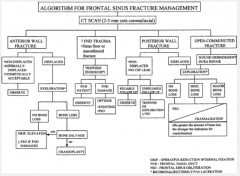
A: ABCs, Abx, tetanus, NSx +/- ophtho consults, CT sinuses, brain & face A: Anterior table Non displaced: Observe Displaced, open or assessing other facial fractures → ORIF or onlay graft of the outer table of calvarium for the bone defect A: Posterior table Non displaced fractures (<1 table width) : Observe +/– trephination in unreliable pt Displaced fractures (>1 table width) : Obliteration (no or minimal bone loss) or Cranialization (severe bone loss); the frontal recess is plugged, pericranial flap or galea frontalis flap used to separate dura from sinus floor; sinus obliteration can be done with fat, bone, hydroxyapatite cement, temporalis muscle, fascia, spontaneous osteoneogenesis A: Frontal recess Minor injury in a reliable pt. → observe & follow with serial CT if needed → if develops obstruction → ESS to open and use a stent of silicon rubber (Parell stent), Draf III or obliteration Major injury → obliterate sinus or cranialize if majority of posterior wall is lost A: Open fractures: explore and decide whether to obliterate or cranialize depending on findings A: CSF Leak: Conservative; if lasts >5 days→ ESS for small defect, transglabeller subcranial approach for large defects * Frontal sinus fracture algorithm in Bailey’s |
|
|
Three early and 3 late complications of frontal sinus fractures |
A: Early (<6 months) – Frontal sinusitis, Meningitis, CSF leak A: Late – Mucocele/mucopyocele, Osteomyelitis, Brain abscess |
|
|
Define the levels of the neck in blunt & penetrating trauma |
A: Zone I – Clavicles to inferior border of the Cricoid A: Zone II – Inferior border of the Cricoid to the Angle of the mandible (most common) A: Zone III – Angle of mandible to Skull base |
|
|
Indications for immediate neck exploration |
A: Massive bleed A: Expanding hematoma A: Non expanding hematoma with hemodynamic instability A: Hemomediastinum A: Hemothorax A: Hypovolemic shock |
|
|
Stages of hypovolemic shock |

|
|
|
Two general categories of penetrating neck trauma |
A: Low velocity (<1000 ft/sec) A: High velocity (>1000 ft/sec) |
|
|
List symptoms, signs and possible investigations for pts with neck trauma? |
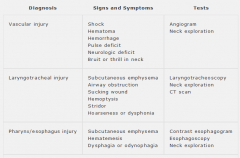
A: |
|
|
Management of Zone I neck trauma |
A: Asymptomatic – Angiography, laryngoscopy, esophagoscopy, +/– gastrograffin swallow, +/– CT, then observation or neck exploration given findings A: Symptomatic – Angiography, then neck exploration 3: Surgical exposures = Left – Anterior thoracotomy, Right – Median sternotomy |
|
|
Management of Zone II neck trauma |
A: Asymptomatic – Directed exam (angiography, esophagoscopy and/or laryngoscopy), then either surgical exploration or serial exams and close observation A: Symptomatic – Neck exploration 3: Surgical exposures = Hockey stick along anterior border of SCM |
|
|
Management of Zone III neck trauma |
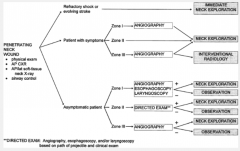
A: Asymptomatic – Angiography, laryngoscopy, esophagoscopy, then observation or neck exploration given findings A: Symptomatic – Angiography, then either neck exploration or interventional radiology 3: Surgical exposures = Extension of Zone 2 incision to include Mandibulotomy or mandible Subluxation * Algorithm for the initial management of patients with penetrating injuries to the neck from Bailey’s |
|
|
Formula to calculate the kinetic energy |
A: KE = 1/2 MV2 |
|
|
Chest X-ray indicators of vascular injury |
A: Widened mediastinum A: Apical capping A: Obscured aortic knob A: Deviated trachea A: Deviated nasogastic tube A: Pleural effusion A: Pneumothorax A: Pneumomediastinum |
|
|
Four general contraindications for ORIF |
A: Patient medically unfit/too unstable for general anesthesia A: Severe comminution A: Lack of soft tissue to cover the fracture site A: Bone severely infected/poor local hygiene |
|
|
Three pitfalls of oral vestibular sulcus incisions for mandibular ORIF |
A: Damage to mental nerve A: Failure of watertight closure A: Failure to resuspend mentalis |
|
|
Three pitfalls of midfacial degloving approach |
A: Damage to infraorbital nerve A: Inadequate mucosa for closure A: Nostril stenosis |
|
|
Three pitfalls of coronal incision |
A: Damage to cutaneous sensory and frontalis muscle innervation A: Inadequate closure of galea A: Brow ptosis |
|
|
Order of approach to complex facial fractures |
A: Mandible – Make certain Maxilla is dissimpacted (Rowe forceps), and place in MMF A: Frontal bar A: Nasoorbitoethmoid and MCL A: Inferior orbital rim and Zygoma A: Orbital floor A: Lefort I – Important to do this last, forgiving 3: Use non-fracture side as a reference if possible 3: Above is top down approach. Other approach is centripetal (outside in), working from skull base and mandible toward midface and working from lateral midface toward medial midface → soft tissue repair (e.g. MCL)→ lacrimal repair |
|
|
Approach to visual loss after trauma |
A: Urgent ophthalmology consultation A: If no light perception, decompression is controversial A: If progressive visual loss, very high dose steroids for 24-48 hours; if no effect, decompression via intracranial, subcranial, or endoscopic approach |
|
|
Discuss the management of Pharyngeal injury from Traumatic Intubation |
A: Minor pharyngeal lacerations – Short course of antibiotics A: Severe injuries (Perforation of the pyriform sinus or esophagus) – Repaired surgically and drained, feeding via nasogastric tube for 5-7 days |
|
|
Discuss Titanium as a facial implant material |
A: Lightweight A: Resists Corrosion A: Soft, deformed by loading forces A: Most Biocompatible – forms titanium oxide on surface (10 nm), interacts with protein for binding |
|
|
Biocompatibility of facial implants |
A: Cells don’t adhere directly A: Substances in extracellular matrix bind the cells to the surface (fibronectin, vitronectin, globulin, proteoglycans) A: Extracellular matrix in bone must mineralize for compression |
|
|
Name the four zones of the circulatory system applied to flap perfusion |
A: Zone I – Macrocirculation = cardiopulmonary system, arteries & veins, lymphatic system; supplies flap through musculocutaneous, septocutaneous branches A: Zone II – Capillary circulation; flow controlled by Precapillary & Preshunt sphinctersPrecapillary sphincters under control by local hypoxia & metabolic byproducts Preshunt sphincters under autonomic control (norepinephrine) for thermoregulation and systemic BP maintenance A: Zone III – Interstitial space & mechanisms of nutrient delivery, including capillary wall; Diffusion (down concentration gradient) & Convection (bulk flow of plasma current) A: Zone IV – Cells and their membranes |
|
|
Classification of Musculovascular pedicles (5) |
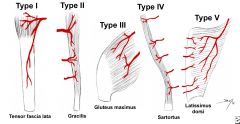
A: Type I – Single pedicle A: Type II – Single dominant pedicle in mid belly of muscle, several minor distally (platysma, SCM, trapezius) A: Type III – Two dominant pedicles (orbucularis oris, rectus abdominis) A: Type IV – Multiple similar size pedicles along the belly A: Type V – Single dominant pedicle and multiple secondary segmental pedicles (pectoralis major, latissimus dorsi) |
|
|
Classification of local skin flaps based on blood supply (3)
|
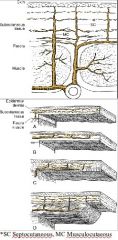
A: Random cutaneous – No named vessels, rely on dermal and subdermal plexus vessels supplied by musculocutaneous arteries near the base of the flap A: Axial pattern/Arterial cutaneous – Incorporates a named subcutaneous artery running along length of the longitudinal axis of flap A: Myocutaneous/fasciocutaneous – Incorporates a segmental vessel that sends perforating vessels to overlying muscle & skin * Classification of skin flaps based on vascular supply. A, Random. B, Arterial cutaneous. C, Fasciocutaneous. D, Musculocutaneous. |
|
|
Five mechanisms of the delay phenomenon in local flaps |
A: Closure of Arteriovenous Shunts – Due to development of autonomous tone or regrowth of sympathetics along flap base, or increased sensitivity to circulating catecholamines A: Reorientation of vessels along axis of the flap A: Increase in vessel Caliber A: Increase in vessel Numbers A: Conditioning of distal flap to ischemia |
|
|
Discuss the No-Reflow phenomenon |
A: Zone II/III failure with intact zone I A: When the critical ischemia time for a flap is exceeded (12 hours), endothelial & parenchymal swelling, intravascular stasis, and thrombosis lead to loss of nutritive flow A: Severity of this effect is correlated with ischemia time A: A unique aspect of free flap physiology is microcirculatory failure related to showers of microemboli from the anastomosis |
|
|
Greatest period of flap failure and most common site |
A: 15-20 min post anastamosis, then the first 3 days A: Venous anastamosis |
|
|
What is the significance of Xanthine oxidase in reperfusion injury? |
A: Major source of free radical in ischemic tissues, responsible for conversion of hypoxantine to uric acid after restoration of oxygen to hypoxic tissue, produces superoxide ions |
|
|
Oxygen free radical scavengers |
A: Allopurinol (xanthine oxidase inhibitors) A: Superoxide dismutase A: Vitamins A, C, E A: Deferoxamine A: Glutathione |
|
|
Flap physiology – Define Stress |
A: Force applied per cross-sectional area |
|
|
Flap physiology – Define Strain |
A: Change in length divided by the original length of the given tissue to which a force is applied |
|
|
Flap physiology – Define Creep |
A: Increase in strain seen when skin is under constant stress A: Mechanical Creep – Occurs over a matter of minutes and is due to an displacement/extrusion of fluid & MPS ground substance from the dermis, and a breakdown of the dermal framework; realignment of collagen, microfragmentation of elastin, migration of undermined tissue into field defect by stretching force A: Biologic Creep – Seen in pregnancy, over weeks, lymphedema, morbid obesity, gradual stress stretches skin, muscles, nerves, blood vessels, lymphatics; increase lengths by cell division and collagen & elastin synthesis |
|
|
Flap physiology – Define Stress Relaxation |
A: Decrease in stress when skin is held in tension at a constant strain/length for a given time; This occurs over a matter of days to weeks and is due to an increase in skin cellularity and the permanent stretching of skin components |
|
|
Discuss Tissue expansion |
A: Expanders – Round, Rectangular, Crescentic; Match geometric shape of expander to the shape of the expansion site & planned flap A: Area of expander ~2.5x that of the defect to be closed; amount of flap advancement either half the base diameter of the expander, or half the diameter of the expansion dome A: Expansion starts ~3 weeks after implant insertion, 6-12 weeks to reach maximum expansionA: Titrate to slight blanching |
|
|
Five complications/emergencies of tissue expanders |
A: Hematoma – truly emergent; return to OR for evacuation, stop bleeding, possibly reinsert expander A: Skin necrosis A: Dehiscence/Implant exposure (most common) A: Extrusion A: Bone remodeling/neurovascular compromise – remove expander or perform surgery ASAP |
|
|
Three Advantages of local flaps |
A: One stage in most cases A: Better donor site match A: Low donor site morbidity |
|
|
Three disadvantages of local flaps |
A: Limited length with random pattern blood supply A: Not enough bulk for deep defects A: Distortion surrounding structures due to donor site closure in some instances |
|
|
What are the three main types of local flaps |
A: Advancement – Monopedicled, Bipedicled, V-Y, or Hinged A: Pivotal – Rotation, or Transposition (Rhomboid, Dufourmental, Bilobed) A: Interpolated – Linear, can be classified as pivotal, but base located some distance away from defect (Paramedian Forehead, Nasolabial, Postauricular) |
|
|
Options for lower lid reconstruction (see trauma section for other format) |
A: Primary closure (30% loss in young and 45% loss in elderly) A: Lateral Cantholysis A: Full thickness skin graft A: Laterally based upper lid graft A: Tenzel rotational flap (up to 50%, laterally based semicircular musculocutaneous flap) A: Mustarde cheek rotational flap (for large defects, single stage, like exaggerated Tenzel, but lacks Orbicularis, so saggs; good for non-seeing eye) A: Free tarsal grafts (for posterior lamella, from ipsi or contralateral lid) A: Hughes procedure (>50%, 2 stage, tarsoconjunctival flap from upper lid, and advancement or FTSG) |
|
|
Options for upper lid reconstruction |
A: Primary closure A: Lateral cantholysis A: Split thickness skin graft A: Sliding tarso-conjunctival flap (posterior lamella from adjacent remaining lid, and advancement or FTSG) A: Posterior lamellar graft with myocutaneous flap (good for lid laxity, can supplement with ear cartilage) A: Pedicled flap from lower lid A: Tenzel flap A: Cutler-Beard bridge flap (>60%, 2 stage, borrows skin/muscle/conjunctiva from lower lid passing under the tarsus, with ear cartilage for support) |
|
|
Five Reconstructive options after Mohs surgery |
A: Secondary intention – Concave areas (nasolabial), medial canthus, perioricular, temporal, and forehead A: Primary A: Skin Graft A: Local flap A: Regional flap |
|
|
Melolabial flap (superiorly based nasolabial) blood supply |
A: Perforators of levator labii superioris muscle, off Angular artery A: ? transverse facial, infraorbital, and ophthalmic arteries (infratrochlear or dorsal nasal) distal to the facial artery in a retrograde flow |
|
|
Nasal tip defect of less than 1.5 cm – alternative to paramedian forehead |
A: Dorsal nasal flap – Advancement flap of dorsal nasal skin based on the dorsal nasal artery; can have an element of rotation from the nasal sidewall |
|
|
Four options for auricular reconstruction |
A: Secondary intention – Lobule and Helix do the worst A: Primary closure – Helical defects <1.5cm A: FTSG – Post-auricular A: Composite graft from opposite ear – Half of the width of defect |
|
|
Blood supply of Regional Skin Flaps |
A: Paramedian forehead – Supratrochlear & Supraorbital arteries A: Forehead – Superficial Temporal artery (used for oropharynx recon) A: Temporoparietal – Superficial Temporal artery & vein A: Postauricular – Posterior Auricular arteryA: Nape of neck – Occipital artery A: Nasolabial – Angular artery off the Facial A: Platysma – Submental branch of Facial (dominant), Transverse Cervical, superior thyroid, post auricular and occipital arteries (secondary) A: SCM – Upper third: Occipital (dominant); secondary branches from Posterior Auricular Middle third: Superior Thyroid Lower third: Suprascapular (most common), transverse cervical or thyrocervical trunk direct branch A: Trapezius – Lateral island flap: Transverse Cervical (dominant) Superior island flap: Occipital and Paraspinous perforators Inferior (lower) island flap: Descending branch of transverse cervical & Dorsal Scapular A: Deltopectoral – 1st-4th perforators from Internal Mammary artery A: Pectoralis major – Thoracoacromial artery, Lateral Thoracic (supplies inferior 1/5th), and Internal Mammary artery perforators |
|
|
Nine Advantages of free flaps over local or regional flaps |
A: Immediate single stage reconstruction A: Two team approach A: Potential for sensate, motor & secretory function A: Improved vascularity and healing A: Large number of donor sites available A: Unrestricted positioning and reach A: Large amount of composite tissue A: Can cover any defect (larger tumor free margins) A: Low rate of resorption A: Permits primary placement of osseointegrated implants |
|
|
Nine characteristics of an ideal free flap |
A: Two team approach for resection and harvest of flap A: Innervation with sensation/motor function feasible A: Adequate length and caliber of vessels A: Donor site previously unviolated A: Minimal donor site morbidity A: Tissue composition similar to that of defect A: Bulk and color matched to that of defect A: Excellent cosmetic potential A: Potential for osseointegration |
|
|
Techniques for Vessels Mismatch |
A: <2:1 – Uneven stitches end to end, dilation A: 2–3:1 – Beveled or spatulation (max angle of beveling is 30 degrees) A: >3:1 – End to side |
|
|
End to side anastamosis – maximum angle of anastamotic vessels
|
A: Less than 60 degrees |
|
|
Five useful clinical signs for monitoring a cutaneous free flap |
A: Color A: Temperature A: Capillary refill A: Palpable pulse A: Needle stick A: Other Ix: Doppler pencil, Temperature probe, Laser Doppler probe, Quantitative fluorometer, Implantable Doppler, Near infra-red spectroscopy |
|
|
Neurovascular supply of the Radial Forearm fasciocutanous free flaps |
A: Artery – Radial artery; perforators travel in lateral intermuscular septum (brachioradialis-flexor carpi radialis) A: Venous – Venae comitantes or Cephalic vein A: Nerve – Medial or Lateral Antebrachial Cutaneous |
|
|
Neurovascular supply of the Lateral arm fasciocutanous free flaps |
A: Artery – Posterior Radial Collateral artery from the profunda brachii A: Venous – Posterior Radial Collateral vein (Venae comitantes) A: Nerves – Posterior Cutaneous nerve of the Arm/Forearm |
|
|
Neurovascular supply of the Lateral Thigh fasciocutanous free flaps |
A: Artery – 3rd perforator of the Profunda Femoris (deep femoral artery), travels in intermuscular septum A: Nerve – Lateral Femoral Cutaneous nerve of the thigh |
|
|
Neurovascular supply of the Anterolateral Thigh fasciocutanous free flaps |
A: Artery – Descending branch of the Lateral Femoral Circumflex artery (branch from the profunda femoris artery), artery descends between the vastus lateralis and rectus femoris muscles A: Nerve – Lateral Femoral Cutaneous nerve of the thigh |
|
|
Neurovascular supply of the Rectus Abdominis myocutaneous free flaps |
A: Vascular – Deep Inferior Epigastric arteries & veins; Inferior pedicle larger and provides the musculocutaneous perforators supplying the skin A: Nerve – any of the Intercostal nerves (lower six) |
|
|
Neurovascular supply of the Latissimus Dorsi myocutaneous free flaps |
A: Vascular – Thoracodorsal vessels, off of Subscapular vessels A: Nerve – Thoracodorsal nerve 3: Can be elevated as a free or regional pedicled flap |
|
|
Neurovascular supply of the Gracilis myocutaneous free flaps |
A: Artery – Terminal branch of Adductor artery, which arises from Profunda Femoris A: Vein – Venae comitantes, join or drain separately into Profunda Femoris vein A: Nerve – Anterior branch of the Obturator nerve (motor supply) 3: Primary use is for facial reanimation |
|
|
Neurovascular supply of the Trapezius myocutaneous free flaps |
A: Superior flap – Occipital artery, Paraspinous muscle perforators; only reliable choice following neck dissection A: Lateral island flap – Transverse cervical artery A: Lower island flap (Extended island) – Descending branches of the Transverse cervical artery and Dorsal Scapular artery |
|
|
Neurovascular supply of the Jejunum visceral free flaps |
A: Vascular – Based on single vascular arcade from SMA (usually 2nd arcade) A: Peristalsis maintained by action of autonomic plexuses |
|
|
Neurovascular supply of the Gastroomental visceral free flaps |
A: Vascular – based on Right Gastroepiploic artery |
|
|
Six mechanisms of action of Hyperbaric oxygen (HBO) |
A: Increases amount of oxygen dissolved in solution A: Increases diffusion distance from capillaries (i.e. the distance Oxygen can diffuse) A: Increases neovascularization A: Increases fibroblast proliferation A: Improves leukocyte oxidative killing A: Antibiotic synergy – Fluoroquinolones, Ampho B, Aminoglycosides |
|
|
What are the 3 phases of irradiated tissue response to HBO |
A: Lag phase – First 8 treatments; Increase in collagen synthesis and capillary budding; Little change in O2 tension (30-50%) A: Rapid Response – 8-22 treatments; Neoangiogenesis, fibroplasias, increase cellularity, increase collagen; Log increase in O2 tension (plateau at 82%) A: Plateau phase – Greater than 22 treatments; Loss of hypoxia, therefore less stimulation for angiogenesis; O2 tension plateaus at 85%3: “Lag 8 Rapid Response 22 Plateau” |
|
|
Seven Indications for HBO |
A: Osteoradionecrosis A: Osteomyelitis A: Necrotizing Fasciitis A: Necrotizing Otitis Externa A: SSNHL A: Preop dental extraction/implant prophylaxis in irradiated patient (20 preop and 10 postop dives) A: Flap failure |
|
|
Six contraindications to HBO |
A: Untreated pneumothorax (absolute) A: Seizure A: Claustrophobia A: Pregnancy A: Neoplasia A: Reactive airways = URTI, Asthma/COPD A: Uncontrollable fever A: meds: Doxirubicin |
|
|
Current protocol for treatment of Mandibular ORN according to Marx |
A: Stage I (Alveolar bone exposed) – Perform 30 HBO dives (1 dive per day, Monday-Friday) to 2.4 atmospheres for 90 Minutes; reassess patient to evaluate decreased bone exposure, granulation tissue covering, exposed bone, resorption of nonviable bone, and absence of inflammation; patients who respond favorably, continue treatment to a total of 40 dives, if not cont to stage II A: Stage II (Does not respond to HBO) – Perform transoral sequestrectomy with primary wound closure followed by continued HBO to a total of 40 dives. Patients who present with orocutaneous fistula, pathologic fracture, or resorption to the inferior border of the mandible advance to stage III immediately after the initial 30 dives A: Stage III (Full-thickness ORN or pathologic fracture) – Perform transcutaneous mandibular resection, wound closure, and mandibular fixation with an external fixator or maxillomandibular fixation, followed by an additional 10 postoperative HBO dives A: Stage IIIR – Perform mandibular reconstruction 10 weeks after successful resolution of mandibular ORN; complete 10 additional postoperative HBO dives |
|
|
Classification of Mandibular bony defects |
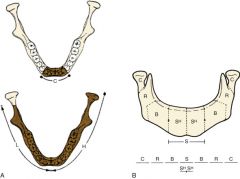
A: Jewer HCL classification: H= hemimandible (L+condyle), L= lateral mandible excluding condyle, C= central segment (incisors and canines) B: Urken’s classification: Condyle (C), Ramus (R), Body (B), Symphysis (S, SH for hemisymphysis) |
|
|
Reconstruction options for TMJ |
A: CondyleAllograft – Condyle prosthesisAutogenous bone (iliac) A: Glenoid fossaPreservation of discFossa prosthesisTemporalis flap A: Costochondral graft (growth center in kids) |
|
|
Reconstruction options for Mandibular defect |
A: AlloplastKirschner wireSteinmann pinsTitanium tray, Screws, PlatesAcrylic A: Autogenous Free bone GraftsCorticalCancellousCorticocancellous blocksParticulate cortical bone combined with cancellous marrow A: Free bone Homograph = Bone trays (ie cadavic)A: Pedicled vascularized bone regional Flaps (5)Rib-PectoralisRib-Lat dorsiScapula-TrapeziusClavicle-SCMCalvarium-TemporalisA: Vascularized bone Free Flaps (8)FibulaScapulaIliacRibRadiusHumerusUlnaMetatarsus A: Distraction Osteogenesis 3: Anterior – Free Fibular (if minimal soft tissue defect) or Scapula (circumflex scapular artery for large tissue defect) 3: Lateral – No reconstruction of mandible (soft tissue only), Low profile plate, Iliac crest (Descending Circumflex iliac artery), or Scapula |
|
|
What is the Axhausen two phase theory of Osteogenesis |
A: Phase I – Initial bone formation comes from surviving transplanted cells, lays down osteoid randomly; Lasts 4 weeks, determines final size of graft A: Phase II – Replaces, reorganizes and remodeling of phase I bone; Last from 2 weeks to 6 months, peak at 6 weeks; Pluripotent host cells transformed into osteoblastic cells, bone morphogenic protein important for fibroblast ingrowth |
|
|
What types of Alloplasts are used in mandibular reconstruction |
A: Pins & wires (Kirschner wire, Steinmann pins) – No longer used anymore due to instability A: Alloplast appliances – Trays made of silicone, polyurethane reinforced Dacron polyester mesh; used as spacer trays or carriers for bone grafts A: Bone plates & screws – Stainless steel, cobalt-chromium, titanium; used most commonly in mandibular reconstruction |
|
|
What are the three types of autogenous bone grafts used in secondary mandibular reconstruction? |
A: Cortical – Lamellar plates of bone, provides the least viable cells, requires long periods for revascularization, provides best rigid support for mandible reconstruction; excellent source of BMP for transformation of pluripotential cells into osteoblastic cells (good for phase II) A: Cancellous – Medullary bone and bone marrow, provides the highest concentration of viable cells which can produce new bone, requires shortest period for revascularization (good for phase I) A: Particulate cortical bone and cancellous marrow contains both medullary and cortical bone, which provides a tradeoff between support and a viable transferable cell population (best osteogenic potential); requires a crib for stability |
|
|
Eight functions of the Oral cavity |
A: Oral competence A: Mastication A: Taste A: Deglutination A: Airway protection A: Respiration A: Oral hygiene A: Articulation |
|
|
Eight goals of primary mandibular reconstruction |
A: Restore mandibular continuity A: Restore lower facial contour A: Reconstruct anatomic configuration of sulcus A: Provide rehabilitation with a functional lower denture A: Maintain mobility of residual tongue A: Improve mastication, deglutition, speech A: Restore sensation to denervated lower lip A: Restore sensation to resurfaced portions of oral cavity |
|
|
Six characteristics of the ideal qualities of the bony component of a vascularized composite free tissue transfer |
A: Adequate length to restore a segmental defect of nearly any length A: Natural shape or easy contourability to match the mandibular defect A: Well vascularized A: Vascular anatomy that is well preserved while contouring the graft A: Sufficient height & width for reliable placement of endosteal dental implants for prosthetic rehabilitation A: No significant functional or esthetic defects at the donor site after harvest |
|
|
Six characteristics of the ideal qualities of the soft tissue component of a vascularized composite free tissue transfer |
A: Accessible for a two team approach A: Well vascularized A: Sensate A: Thin and pliable A: Mobile relative to bone A: Minimal morbidity at the donor site A: Lubricated |
|
|
Neurovascular supply of the Fibula the osseous composite free flaps |
A: Vascular – Peroneal artery & vein; perforators run in posterior intermuscular septum A: Nerve – Lateral sural cutaneous A: Bone – Up to 25cm of bone available, contourable due to segmental blood supply; leave 8-10cm superiorly and inferiorly. 3: Blood supply to skin not completely reliable; loss in 5-10% of cases |
|
|
Neurovascular supply of the Iliac Crest osseous composite free flaps |
A: Artery – Deep Circumflex Iliac artery off of External Iliac artery; (just above inguinal ligament), Internal Oblique supplied by ascending branch of DCIA A: Venous – Deep Circumflex Iliac vein 3: Natural shape conforms to that of native mandible (use ipsilateral hip) |
|
|
Neurovascular supply of the Scapula osseous composite free flaps |
A: Artery – Circumflex Scapular artery off of Subscapular artery, divides into Transverse & Descending branches to supply two separate skin paddles (scapular & parascapular respectively) A: Venous – Vena comitantes A: Bone – Separate Thoracodorsal blood supply to bony component (Angular branch), 10-12cm length from inferior lateral aspect of bone 3: Not suitable for osseointegration |
|
|
Neurovascular supply of the Radial Forearm osseous composite free flaps |
A: Vessels – Radial A: Up to 10 cm and 40% of radial circumference can be taken 3: Not suitable for osseointegration |
|
|
Neurovascular supply of the Lateral Arm osseous composite free flaps |
A: Vessels – Posterior radial collarteral artery of Profunda Brachii artery 3: Up to 10 cm and 1/6th of humeral circumference can be taken |
|
|
Neurovascular supply of the Dorsalis Pedis osseous composite free flaps |
A: Artery – Dorsalis Pedis artery A: Nerve – Superficial Peroneal nerve 3: Thin sensate cutaneous flap from dorsal foot; 2nd metatarsal included for osseocutaneous flap |
|
|
Neurovascular supply of the Rib osseous composite free flaps |
A: Intercostal vascular pedicle; Marginal blood supply to skin |
|
|
What are the three classes of dentures used for dental rehabilitation post mandibulectomy? |
A: Tissue-borne prosthesis – Simplest, complete or partial, stabilized by remaining teeth and a broad denture supporting area A: Implant-assisted prosthesis – Osseointegrated posts help stabilize the dentures against lateral displacement forces with use; more stable than conventional dentures, cheaper than implantborne prosthetics A: Fixed implant-borne prosthesis – Most stable form of restoration, supported by 5-6 fixtures attached to transepithelial connector implants, denture does not come into contact with the underlying mucosa |
|
|
Surgical Strategies to increase support for dental prosthesis |
A: Remove tooth and cut through a socket A: Preserve anatomy – Mandible (Alveolus, retromolar pad, buccal shelf), Maxilla (Tuberosity, alveolus, hard palate) A: Preservation of strip of mucosa – Make the mucosal cuts closer to the specimen than the bony cuts as to use the mucosa to fold into the defect A: Avoid true hemimaxillectomy – Save medial and lateral incisor for tripod effect A: Skin grafting of cheek flap, and areas of the obturator contact A: Skin grafting of the maxillary sinus A: Resection of inferior turbinate |
|
|
Classification of Obturators |
A: Surgical A: Postsurgical A: Definitive |
|
|
Borders of vermilion |
A: Vermilion border A: Innermost point of mucosa where lips contact 3: Made up of modified mucosa |
|
|
Options for reconstruction of Floor of Mouth |
A: Secondary intention A: Primary closure A: Dermal graft A: STSG (small defect) A: Local flaps – Nasolabial flap (moderate defect) A: Regional flaps (moderate defects) Forehead flap (superficial temporal artery) Submental artery island flap (submental branch of facial art) Facial artery musculomucosal flap (FAMM; includes some buccinator, and buccal fat) Platysma flap Deltopectoral flap (historical) Pec flap A: Free tissue transfer – Radial forearm Lateral arm Anterolateral thigh |
|
|
Options for reconstruction of Anterior Tongue |
A: Up to 50% resection, no reconstruction – Secondary intention, primary closure, STSG or dermal graft only A: Larger or composite resection – Free Radial forearm, or Lateral arm flap/ALT for increased bulk |
|
|
Options for reconstruction of Buccal mucosa |
A: Small – Primary closure, STSG, or dermal graft A: Moderate – Temporoparietal fascia flap (with STSG) A: Larger/full thickness – Regional (Pectoralis major or Lat dorsi), or Free flap |
|
|
Total Glossectomy reconstruction |
A: Pec major A: Rectus abdominus A: Lat dorsi A: ALT flap |
|
|
Anticoagulation in free flaps |
A: Aspirin – Inhibits cyclooxygenase, interferes with PGH2 synthesis; 81 or 325 mg A: Heparin – Binds to antithrombin III, inactivated thrombin, other esterases; increases electronegative potential of endothelium, thus decreases platelet adhesiveness A: Dextran – Antithrombin & antifibrin effects, Either 40 cc of Dextran 40 followed by 25 cc/h x 5 days; or 500 cc followed by 500 cc/d x 3 days A: Medicinal leech – Indication = venous congestion; produce Hementin (local anesthetic), Hirudin (inhibits fibrinogen to fibrin conversion); Risk = Aeromonas hydrophila – gram negative ßlactamase producing commensal organism, causes necrotic soft tissue flap infection in 10-15%, cover with prophylactic Fluoroquinolone x3-5 days |
|
|
Mechanisms of Dextran |
A: Decreased viscosity leads to improved capillary blood flow A: Decreased platelet adhesiveness A: Alters fibrin structure A: Antithrombotic effect starts 2-4 hours after infusion starts 3: Adverse reactions include anaphylaxis (test preop), pulmonary edema due to fluid overload, ARDS and nephrotoxicity |
|
|
Five things to consider when hiding facial incisions |
A: Scars best hidden if within or parallel to RSTL’s A: Junction of aesthetic subunits A: Place within skin creases or folds A: Locations that can be hidden by hair (requires incision parallel to follicles) A: Use of squamomucosal incisions (margins of orifices) 3: Other possible answers include Placing scars as far from midline as possible, and using a Geometric broken line, W plasty or Z plasty |
|
|
Six considerations to minimize scar tissue formation when repairing facial laceration |
A: Tissue eversion A: Patient’s propensity for keloid/hypertrophic scar A: Patient’s natural complexion, eg. light vs. dark skin A: Minimal tension on incision line A: Clean wound, avoidance of infection A: Absorbable vs. Nonabsorbable sutures |
|
|
Three indications for scar revision |
A: Scars >2 cm in length or >2 mm in width A: Does not lie in RSTL A: Distortion of normal anatomy |
|
|
Five characteristics of the ideal scar |
A: Flat, level with skin A: Narrow A: Parallel to RSTLs A: Same Color A: No long unbroken segments |
|
|
Methods of scar irregularization |
A: Z-plasty – Single or compound; best for scars across concavities (ie. webbing or banding) A: W-plasty – Best for long scars along curves (eg. angle of mandible); base <6mm, sides <6.5mm A: Geometric broken line – Best technique for long unbroken facial scars; shapes should be <5-6mm in any dimension |
|
|
Three indications for Z-plasty |
A: Rotation of the dominant axis of a scar, especially those that cross RSTLs A: Reduction of scars distorting anatomic landmarks A: Avoidance of a web or band across a concavity |
|
|
Five advantages of Z-plasty |
A: Axis of scar changes A: Lengthens scar A: Tension redistribution A: Defect Closure A: Normal tissue brought in |
|
|
Theoretic increases in length with varying Z-plasty angles |
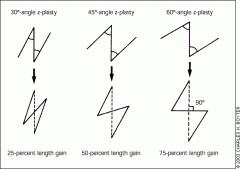
A: Less than 30 degrees – Tip necrosis A: 30 degrees = 25% A: 45 degrees = 50% A: 60 degrees (classic) = 75% A: Greater than 75 degrees = Redundant standing cones |
|
|
Ratio of facial width/length |
A: ¾ |
|
|
Width of face divided into fifths, where are vertical lines placed? |
A: Each fifth = ~1 eye width, and ~ nasal width A: At the edge of each eye, from medial canthus to lateral canthus A: Medial canthus roughly equal to lateral edge of nasal alae |
|
|
Height divided into equal thirds, where are the horizontal lines? |
A: Trichion-Glabella A: Glabella-Subnasale A: Subnasale-Menton |
|
|
Frankfort plane passes through which structures? |

A: Upper EAC margin A: Inferior orbital rim *Frankfurt Horizontal plane |
|
|
Excluding the upper third, what are the proportions of nasion (instead of glabella) to subnasale : subnasale to menton? |
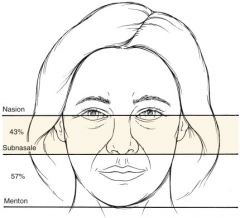
A: Nasion to subnasale: 43%, Subnasale to menton 57% |
|
|
Define the Gonzalez-Ulloa line |
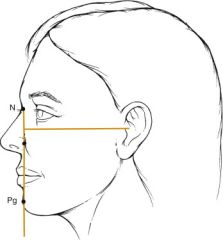
A: In the facial profile view, it is perpendicular from the Frankfort line, passing through the Nasion A: Midforehead, Subnasale, upper/lower Lips, Pogonion all lie on the line |
|
|
Eye analysis |
A: Palpebral fissure ~10 mm A: Horizontal width ~30 mm (1/5th width of face) A: Intercanthal distance (30-35 mm) = ½ interpupillary distance (60-70mm) A: Upper eyelid covers a small portion of the iris (1-2mm?) A: Lower eyelid within 1-2 mm of iris A: Upper eyelid crease 11 mm above lash line |
|
|
Ideal eyebrow position (Ellenbogen and Westmore criteria)? |
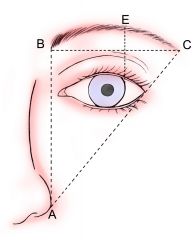
A: Medial edge lies on a perpendicular line that passess through the lateral most portion of nasal ala, 10 mm above medial canthus A: Lateral edge lies on an oblique line passing through ala & lateral canthus A: The medial and lateral ends of the eyebrow should lie at approximately the same horizontal level A: Highest point (peak) lies directly above lateral limbus in women (to lateral canthus) A: The eyebrow arches above the supraorbital rim in women and lies at or close to the rim in men *Ideal eyebrow position |
|
|
Nose analysis |
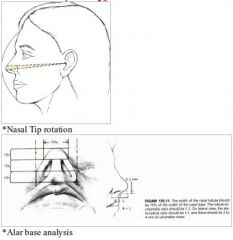
A: Nasal Width from alar groove to alar groove = 70% the Length of the nose from nasion to tip defining point; nasal width equal to intercanthal distance A: Nasion at level of upper eyelid A: Four profile measuresContour – should be relatively straightProjection – extent of tip protrusion from the anterior facial plane; tip defining point to base of the alaRotation – angle of inclination of the nasolabial angle, it occurs along an arc produced by a radius based at the external auditory canalLength – dorsum measured from nasion to tip defining point A: Alar base analysis: see pic below |
|
|
Methods of determining Tip Projection |
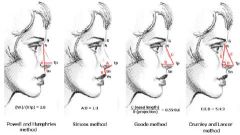
A: Powell & Humphreys – Height measured from Nasion to Subnasale, perpendicular drawn through Tip defining point, ratio of N-X/X-Tp ideally 2.8:1 A: Goode – line drawn from the alar-facial groove to the nasal tip measures 0.55-0.60 of the distance from the nasion to the nasal tip A: Crumley & Lancer – Defined relationship of tip projection, vertical height, nasal length as a right triangle whose sides follow a 3:4:5 ratio respectively A: Simon – Tip projection (measured from Tip defining point to Subnasale) and length of the Upper Lip (measured from subnasale to upper vermilion border) should be equal (1:1) *Tip projection methods |
|
|
Chin position analysis |
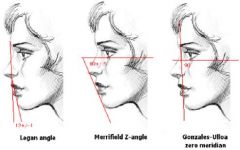
A: Gonzales-Ulloa zero meridian (nasion): should hit pogonion A: Legan angle – Tangents through Subnasale to Glabella, and Subnasale to Pogonion = 12 +/– 4 degrees (“Legan is Some Glutenous Pig!”) A: Merrifield Z angle (Frankfort plane and Pogonion to Anterior Lips) = 80 +/– 5 degrees A: Mentolabial sulcus should be 4 mm posterior to vertical line from subnasale to labrale inferius to pogonion (see lip section) A: Vertical line from Inferior Vermilion border (perpendicular to Frankfort plane) determines position; male Pognonion should be tangential to line, female 2-3 mm posterior to the line (?same as above) A: Length – Menton to suprasternal notch should be 50% of the head height (from vertex to menton) *Chin analysis methods |
|
|
Gonzales Ulloa staging for chin retraction? |
A: First-degree retraction describes the pogonion at less than 10 mm behind the 0° meridian. A: Second-degree retraction is in the range of 10-20 mm. A: Third-degree retraction is more than 20 mm. |
|
|
Hinderer’s method for malar eminence position |
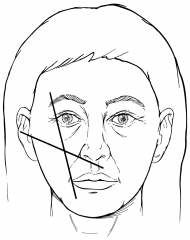
A: Two lines drawn, one from Lateral Canthus to lateral Commissure, other from Tragion to lateral Ala A: Malar prominence should be in upper lateral angle formed from the lines’ intersection *Malar eminence position should be in upper lateral angle |
|
|
Lip analysis |
A: Upper lips – from Subnasale to Stomion = 1/3 lower facial thirdA: Lower lip – from Stomion to Menton = 2/3 lower facial third A: Upper lip fuller, projects slightly more than lower A: Oral commissure on same vertical line as Medial Limbus A: Lip position (Cummings): Perpendicular line from subnasale to labrale inferius (vermillion of lower lip) to pogonion → anterior most of upper lip should be 3.5mm anterior to this line and lower lip 2.2mm Nasomental angle (see below): upper lip should be 4mm posterior to line and lower lip is 2mm |
|
|
Ear analysis |
A: Height ~6cm A: Width 0.55-0.6 of the Height A: Top of Helix at same level as lateral Brow A: Helical Root at same level as lateral Canthus A: Inferior attachment at same level as Alar-Facial junction A: Long axis (posterior) parallels the Nasal Dorsum A: Short axis (anterior) is inclined ~20 degreesA: Protrusion from posterior skull 20-30 degrees, approximately 15-25 mm |
|
|
Identify the 5 profile angles for facial analysis |
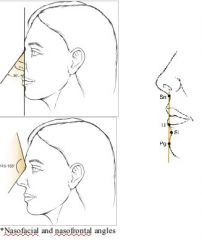
|
|
|
What 4 angles make up the aesthetic triangles of Powell & Humphries? |
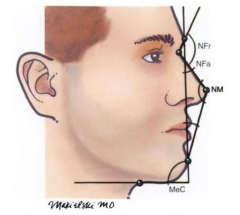
A: Nasofrontal angle = 115-135 o A: Nasofacial angle = 30-40 o A: Nasomental angle = 120-132 o A: Mentocervical angle = 80-95 o *Aesthetic triangle of P&H |
|
|
List the facial aesthetic units? |

A: Forehead A: Eyes A: Cheek A: Nose A: Lips A: Chin A: Ears A: NeckSee below pics for subunits of some of the above (different sources say different things and this is probably too detailed) *1, Forehead unit (1A, central subunit; 1B, lateral subunit; 1C, eyebrow subunit); 2, nasal unit; 3, eye lid units (3A, lower lid unit; 3B, upper lid unit; 3C, lateral canthal subunit; 3D, medical canthal subunit); 4, cheek unit (4A, medial subunit; 4B, zygomatic subunit; 4C, lateral subunit; 4D, buccal subunit); 5, upper lip unit (5A, philtrum subunit; 5B, lateral subunit; 5C, mucosal subunit); 6, lower lip unit (6A, central subunit; 6B, mucosal subunit); 7, mental unit; 8, auricular unit; 9, neck unit. * Auricular unit. 1, Helical subunit; 2, antihelical subunit; 3, triangular fossa subunit; 4, conchal subunit; 5, lobe subunit. |
|
|
List the 6 aesthetic subunits of the nose (3 are paired) |
A: Dorsum A: Sidewalls (2) A: Tip A: Nasal ala (2) A: Soft triangle (2) A: Columella |
|
|
Draw the facial RSTL? |
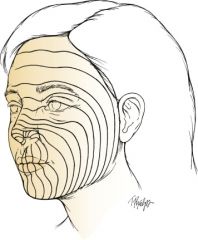
A: |
|
|
Name the important muscles of the nose (NB exam asked for 4 elevators and 4 depressors) |
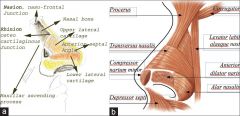
A: Elevators Procerus Levator Labii Superioris Alaque Nasi Anomalous Nasi A: Depressors Alar Nasalis (Dilator naris posterior) Depressor Septi A: Compressors Transverse Nasalis Compressor Narium Minor A: Minor dilators Dilator Naris Anterior & Posterior (alar nasalis) |
|
|
Define the Tip Defining Point |
A: Highest, medial and cephalic portion of the lateral crus that corresponds to the light reflex externally |
|
|
Name the 3 Major & 6 Minor nasal tip supports according to Tardy’s classification? |
A: Major: Size, shape, & resiliency of medial & lateral crura Attachment of medial crural foot plate to the caudal border of quadrangular cartilage Attachment of upper lateral cartilages to alar cartilages A: Minor: Attachment of the alar cartilages to the overlying skin and musculature Sesamoid complex extending the support of the lateral crura to the pyriform aperture Ligamentous sling spanning the paired domes of the alar cartilages Bony nasal spine Cartilaginous septal dorsum Membraneous septum |
|
|
What anatomic variations are there in the attachment of the upper and lower lateral nasal cartilages? |
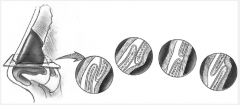
A: Cephalic end of lower lateral cartilage usually overlies the caudal end of the upper lateral cartilages A: Interlocking scroll 52% A: Overlapping 20% A: End-to-end 17% A: Opposed scroll 11% * Anatomic relations between the cephalic margin of the lower lateral cartilage and the caudal margin of the upper lateral cartilage |
|
|
Define Keystone area |
A: Overlap of the Upper lateral cartilage by Nasal bone |
|
|
Ten indications for external (open) rhinoplasty (NOT OPEN REDUCTION!) |
A: Major reconstruction A: Extensive Tip work A: Non-Caucasian nose A: Crooked nose (lower two thirds)/Eccentric anatomy A: Revision rhinoplasty A: Saddle nose deformity A: Closure of septal Perforation A: Cleft lip nasal deformity A: Benign nasal Tumors A: Teaching |
|
|
Contraindications of open rhinoplasty (emedicine)? |
A: Intranasal substance abuse (eg, cocaine)A: Psychological or psychiatric instability A: SIMON (single, immature, male, overly expectant, narcissistic) personality traits A: Comorbid medical conditions that preclude surgical clearance A: Preoperative diagnosis of nasal dysfunction (with or without aesthetic deformity) that may be better treated with a closed approach (ie, septoplasty for airway obstruction) or medical management A: Patient refusal of external scar A: Very thick nasal skin in which postoperative edema can be permanent |
|
|
Describe the blood flow to the nasal tip |
A: Dorsal nasal artery (2) – terminal branch of the Ophthalmic artery, runs along dorsum near the midline A: Lateral nasal artery (2) – branch of the Facial artery A: Columellar artery (2) – branch of the Superior Labial artery |
|
|
What are the three anatomic angles composing the caudal aspect of the nasal quadrangular cartilage? |
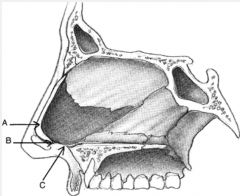
A: Anterior: forms the transition between the dorsal and caudal septum, most important, LLCs are in intimate proximity → deviation leads to distortion of nasal tip A: Intermediate: in betweenA: Posterior: just above the articulation of the quadrangular cartilage and the nasal spine, it supports the feet of the medial crura *A: Anterior, B: Intermediate, C: posterior |
|
|
Describe the Incisions used in surgery of the nasal tip |
A: Intercartilaginous A: Intracartilaginous A: Marginal |
|
|
Describe the Approaches used in surgery of the nasal tip |
A: Delivery – For more abnormal or asymmetric tip anatomy, allows presentation of the alar cartilages as bipedicled chondrocutaneous flaps for surgical modification A: Nondelivery – For conservative/minimal tip refinement, disturbs little of the normal anatomy (Cartilage splitting, or Retrograde) A: Open – External |
|
|
Describe the Techniques for Volume Reduction used in surgery of the nasal tip |
A: Residual complete strip – Conservative cephalic trim; whenever possible, ideal to leave a complete strip of lateral crus of at least 5 mm in width A: Weakened complete strip – For further refining of tip, done by conservative cross hatching, morselization, or incomplete noncoalescent dome incisions A: Suture modification of complete strip A: Interrupted strip – For severe tip deformities, increased risk of asymmetric healing & scarring, causes increased cephalic tip rotation 3: In addition to volume reduction, other techniques include reconstruction, excision, augmentation, reorientation |
|
|
Methods of Increasing Tip Projection in rhinoplasty |
A: Columellar strut grafts placed between the medial crura A: Shield or onlay grafts overlying the dome A: Plumping grafts to the columellar-labial angle A: Lateral crural steal (also increases rotation)A: Vertical dome division using lateral crural recruitment (Goldman tip) A: Transdomal suturing A: Tongue in groove (buried Septocolumellar sutures) A: Illusionary – Reduction of cartilaginous dorsum/enhancing supratip break A: Dynamic adjustable rotational tip tensioning (DARTT) 3: Any combination of above can be used; Preservation – Maintain tip support mechanisms; complete strip techniques with avoidance of complete transfixion incision 3: Causes of underprojection: Hypoplastic nasal spine/maxilla, short septum, short/weak medial crura, posterior attachment of medial crura to septum |
|
|
Methods of Decreasing Tip Projection in rhinoplasty |
A: Complete transfixion A: Resection of caudal septum A: Nasal spine reduction A: Vertical dome division with excision of excess medial crura & suture reapproximation A: Dettachment of ULC & lateral attachements of LLC A: Lateral crural overlay (also increases rotation) A: Excision & suture part of medial & lateral crura of alar cartilage A: Tongue in groove 3: Causes of overprojection: Prominent nasal spine/septum, long medial crura, and anterior attachment of medial crura to septum. |
|
|
Six methods of Increasing Tip Rotation in rhinoplasty |
A: Interrupted strip technique – Fosters cephalic tip rotation, especially if performed lateral to domes A: Shorten lateral crura A: Residual complete strip – Conservative cephalic or caudal trim of lateral crura A: Caudal septal shortening +/– high septal transfixion A: Shorten overlong upper lateral cartilages A: Reduction of convex caudal medial crura A: Illusionary – Cartilage grafts in the lobule, columella, nasolabial angle (plumping grafts) A: Tongue in groove A: Minor – Resection of excess vestibular skin A: Minor – Cutting of depressor septi muscle A: Minor – Proper taping 3: Volume reduction of alar cartilages with complete strip or incomplete strip (more pronounced with incomplete); Can control complete strip resection with base up triangle resection laterally); If using complete strip, use adjunctive procedures to augment 3: Causes under-rotation: Laxity of ULC/LLC connection, long ULC, Caudal position of LLC compared to septum (too much tip for septum), Long lateral crura |
|
|
Five methods of Decreasing Tip Rotation in rhinoplasty |
A: Resection of caudal septum near spine A: Shorten medial crura of alar cartilage with interrupted strip A: Dorsal graft augmentation A: Infratip button A: Detach ULC from LLC A: Tongue in groove 3: Causes of over-rotation: Short ULC, Long medial crura, short Lateral crura, LLC positioned high on septum |
|
|
Causes of bulbous tip? |
A: Thick skin A: Large lateral crura A: Wide interdomal distance A: Wide intermediate crus |
|
|
Treatment of bulbous tip? |
A: Interrupted strip with excision of part of lateral crura A: Domal suture techniques A: Vertical dome division |
|
|
Etiology of nasal tip Bosselation |
A: Primary nasal tip asymmetry A: Iatrogenically created sharp edges A: Too narrow a rim strip |
|
|
Treatment of nasal tip bosselation |
A: Raise low side A: Lower high side A: Combination of above |
|
|
Etiology and treatment of nasal tip pinching |
A: Etiology – Overresection of lateral crural cartilage A: Treatment – Replacement with nasal septal cartilage, precise pocket formation |
|
|
Five broad etiologies of Saddle nose deformity |
A: Congenital – Achondroplasia, Apert’s syndrome A: Traumatic A: Postinfectious – Septal hematoma/abscess A: Iatrogenic – Post-SMR or SRP A: Systemic disease – OWR, WG, relapsing polychondritis |
|
|
Therapeutic options for saddle nose deformity |
A: Nasal tip retrodisplacement (for tip overprojection) A: Lateral osteotomies A: Autogenous Graft – Bone/rib or cartilage grafts A: Homograft – Demineralized bone (significant long term resorption), Irradiated cartilage (unnatural feel, long term resorption), Acellular dermis (Alloderm) A: Alloplasts – Silastic, Proplast, GoreTex, Mersilene |
|
|
Define Nasal sill |
A: Nostril rim between attachment of medial crus and attachment of ala to the face |
|
|
Define Flare |
A: Amount of alar tissue lateral to the alar-facial junction |
|
|
Two indications for Alar base resection (Weir) |
A: Reduction of nasal tip projection in Caucasian rhinoplasty A: Nasal width reduction in Non-Caucasian rhinoplasty |
|
|
Correction of the Hanging Columella |
A: Restore rotation & projection to the lower third of the nose A: Resection of caudal septum with excess vestibular skin A: Trim the caudal medial crura |
|
|
Etiology of Alar Retraction |
A: Congenital causes A: Overresection of lateral crural cartilage and vestibular skin 3: Poor alar-columellar relationship (bilateral alar retraction in this case) |
|
|
Treatment of Alar Retraction |
A: Shorten columella A: Shorten contralateral ala A: Cartilage graft for minimal retraction A: Composite graft for extensive retraction |
|
|
Etiology of columellar retraction |
A: Congenital A: Alar-columellar disproportion A: Traumatic A: Iatrogenic |
|
|
Treatment of columellar retraction |
A: Raise ala A: Cartilage graft A: Composite graft (if membranous lining deficient) |
|
|
Define “Polly-Beak” deformity |
A: Supratip swelling A: Usually secondary to unsuccessful rhinoplasty |
|
|
Six causes of “Polly-Beak” deformity |
A: Skin – Thickened/inflamed secondary to surgery, excess supratip scar tissue formation A: Subcutaneous tissue – Granulation in subcutaneous dead space secondary to excessive excision of cartilaginous dorsum A: Bony nasal dorsum – Excessive resection A: Cartilaginous nasal dorsum – Inadequate excision of the dorsal border of the septum leading to projecting excess septal dorsum A: Upper lateral cartilage – Inadequate excision leading to projecting excess cartilage A: Lower lateral cartilage – Excessive tip resection leading to loss of tip support |
|
|
Treatment of “Polly-Beak” deformity |
A: Steroid injection A: Supratip scar excision A: Augmentation of tip support – Lower lateral cartilages A: Augmentation of tip projection – Columellar strut grafts A: Augmentation of dorsal profile – most effective; can use cartilage grafts, implants, or both 3: Choice of method depends on cause |
|
|
Etiologies of Midnasal asymmetry |
A: Nasal bone Disparity A: Upper lateral cartilage Subluxation A: Upper lateral cartilage Overexcision A: Nasal Septal deviations |
|
|
Treatment for Midnasal asymmetry |
A: Appropriate nasal bone restructuring A: Onlay grafts A: Spreader grafts A: Septal corrections |
|
|
Etiology & treatment of inverted V deformity? |
A: Disarticulation of key-stone area (attachment of ULC to nasal bone) A: Tx: re-suspend ULC, dorsal augementation |
|
|
Fat compartments of Upper Eyelids |
A: Central & nasal/medial A: Divided by Superior Oblique 3: Lacrimal gland located laterally |
|
|
Fat compartments of Lower Eyelids |
A: Medial, central & temporal/lateral A: Central & medial compartments divided by Inferior Oblique A: Central & lateral compartments divided by fascial sling (thearcuate expansion of the capsulo-palpebral fascia) |
|
|
Name the 3 parts of the orbicularis oculi muscle |
A: Pretarsal – Overlying tarsal plate A: Preseptal – Overlying orbital septum A: Orbital – Overlying bone surrounding the orbit |
|
|
What are the 4 layers of the upper lid at the lid margin? |
A: Skin A: Orbicularis oculi A: Tarsal plate A: Conjunctiva |
|
|
What are the 7 layers of the upper lid above the eyelid crease? (SOS FAMC) |
A: Skin A: Orbicularis oculi A: Orbital Septum A: Orbital Fat pad A: Levator aponeurosis A: Muller’s muscle A: Conjunctiva |
|
|
Four things to evaluate when planning an Upper Lid Blepharoplasty |
A: Brow ptosis, possible need for browplasty? A: Skin type determines aggressiveness of resection A: Presence of Lagophthlamos (inability to close eyelids completely) A: Test for presence of Bell’s phenomenon (defensive rolling of eye upward on side with incomplete eyelid closure) |
|
|
Things to evaluate when planning a Lower Lid Blepharoplasty |
A: Fat pseudoherniation only, or is there skin & muscle redundancy also? A: Laxity – Snap test and Pinch/Distraction test (6 mm) |
|
|
What are the most common muscles injured in blepharoplasty? |
A: Upper lid – Superior Oblique A: Lower lid – Inferior Oblique |
|
|
Complications of Blepharoplasty (Esthetic & Non-Esthetic) |
A: Lagophthalmos A: Ptosis A: Scleral show A: Ectropion A: Chemosis A: Contour irregularity/asymmetry A: Infection A: Bleeding – Retrobulbar Hematoma, or external A: Subconjunctival ecchymosis A: Scarring A: Blindness A: Extraocular muscle injury A: Milia formation A: Corneal abraison A: Epiphora A: Worsening dry eye |
|
|
Emergency management of a Retrobulbar Hematoma |
A: Urgent Ophthalmology consult A: IV Mannitol 20% over 20-30 min(100 g in 500 cc bag) A: Acetazolamide 500 mg IV q2-4 h A: Steroids (controversial) A: +/– Lateral canthotomy and cantholysis, followed by definitive Orbital decompression A: release bleph incision sutures |
|
|
Eight Histologic changes in aging skin |
A: Decreased moisture content & cellular cohesion of the stratum corneum A: Decrease in Melanocytes & Langerhans cells A: Effacement of rete ridges A: Thinning of the Dermis A: Thickened dermal Collagen but overall decrease in amount A: Elastic fibers of dermis become thin & fragmented A: Smaller Sebaceous glands A: Reduced Vascular supply |
|
|
Seven changes in the aged nose |
A: Skin thinner and less elastic A: Nasal bones osteoporotic A: Cartilage ossification A: Loss of attachments between upper & lower cartilages A: Alar cartilage flattens & fragments A: Elongation of the mid & lower portions of the nose A: Nasolabial angle below 90 degrees |
|
|
The facial nerve innervates the facial mimetic muscles from their deep surfaces except for which three? |
A: Mentalis A: Levator Anguli oris A: Buccinator3: “Mother Lifts (Angry) Baby” |
|
|
Rhytidectomy general points |
A: General anaesthetic A: SMAS suspension key – either imbrication or plication; superior and posterior vectors of pull A: Deep plane rhytidectomy – to correct aging changes ofmelolabial fold and malar area A: Combination of rhytidectomy with submental liposuction andplatysmaplasty 3: Ideal patient – Strong angular bony facial structure, thin skin with mobile subcutaneous tissue, minimal subcutaneous fat, long columnar neck, cephalically positioned hyoid, long strong mandible, well defined cervicomental angle (90 degrees) |
|
|
Rhytidectomy preoperative evaluation important points? |
A: SAFE: Self-image, anxiety, fear, expectation A: Medical Hx: smoking, DM, HTN, CVD, bleeding d/o, keloid, psych Hx A: Meds: ASA, steroids, Vit. E, Ginko, selenium, Accutane |
|
|
Complications of Rhytidectomy |
A: Hematoma – Most common complication (8.5%) A: Nerve damage – Most common sensory nerve injured is theGreater Auricular; Facial nerve damage is uncommon, Frontal branch (Baileys), Marginal Mandibular (Cummings) and Buccal at risk, avoided by not elevating past the anterior border of the parotidA: Infection A: Incision problems – avoid tension on incision lines A: Scar A: Seroma/Sialocele A: Skin slough A: Pixie ear – Elongated earlobe attached directly to the facial cheek skin A: Hairline changes A: Alopecia 3: “He Never Insists So Please Have A Piece!” |
|
|
Management of the Aging Neck – Dedo’s Classification (Bailey, p.2654) and Treatment |
A: Type 1 – Young, well-defined neck A: Type 2 – Skin ptosis; Management requires redraping of the skin A: Type 3 – Subcutaneous/Submental Fat accumulation; Management through liposuction, either endoscopic or open A: Type 4 – Platysma Muscle accentuation/banding; Platysmaplasty with anterior/posterior tightening, submental tuck A: Type 5 – Retrognathia, congential or aquired; Suspension of tightened platysma from mandible, chin implant A: Type 6 – Pathologic low Hyoid – Ideally should be posterior and high up (at level of C4), if not, cut ¾ of anterior belly of digastric for preferential posterior belly action, or delineate acute cervicomental contour by suture suspension |
|
|
Six considerations for surgery of the aging Forehead |
A: Hairline patterns A: Skin type A: Presence of rhytids A: Brow ptosis A: Brow asymmetries A: Bony contour |
|
|
Seven surgical approaches to the forehead |
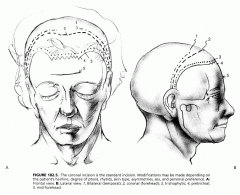
A: EndoscopicA: Bicoronal A: Bliateral temple lift A: Trichophytic – For high hairline A: Pretrichial A: Midforehead – Browplasty, rhytidectomy; for deep creases A: Direct brow lift – For facial paralysis A: Browpexy (through a standard blepharoplasty incision) |
|
|
Muscles encountered in Forehead Rhytidectomy from deep to superficial, which muscles are cut and how? |
A: Frontalis – horizontal relaxing incisions made between midpupillary lines A: Corrugator Supercilii – excised to eliminate vertical rhytids A: Procerus – excised to eliminate horizontal rhytids A: Orbicularis oculi – typically spared during rhytidectomy |
|
|
Describe 6 SMAS connections/relationships from superior to inferior |
A: SMAS equivalent to Galea A: Becomes temporoparietal fascia (same as superficial temporal fascia) A: Thins over zygomatic arch A: Envelopes zygomaticus major – has cutaneous attachments at nasolabial fold A: Superficial to parotid fascia A: SMAS becomes platysma in the neck – Dehiscent medially and lateral to angle of mandible A: Attaches to the fascia of the SCM laterally |
|
|
Three nerves most at risk in Face Lift |
A: Greater Auricular N (most common) A: Frontal (least likely to recover) A: Marginal mandibular 3: KJ says the Auriculotemporal is number 1 (I think he’s on crack!) |
|
|
Facial danger zones? |

A: |
|
|
Where does Frontal branch cross the arch of the Zygoma |
A: 2 cm posterior to Lateral Canthus A: Pitanguy’s line: tragus to lateral brow |
|
|
Marginal Mandibular is protected by platysma except for.. |
A: Area 2 cm from Oral Commissure |
|
|
Plane of Frontal branch above Zygoma |
A: Between SMAS(=TPF=superficial temporal fascia) and superficial layer of the Deep Temporal fascia |
|
|
Safe dissection plane at level of Zygoma and above zygoma |
A: Over Zygoma – Subperiosteal A: Above Zygoma – Deep to the Superficial layer of the Deep Temporal fascia (sub-follicular plane) |
|
|
Zygomatic and Buccal branches – safe dissection plane |
A: Supramuscular (innervates muscle on deep surface, except for Mentalis, Levator anguli oris, and Buccinator) |
|
|
Five planes of skin in neck |
A: Superficial Subcutaneous A: Mid-subcutaneous A: Supraplatysma (ie SupraSMAS) A: Subplatysma (ie SubSMAS)A: Subperiosteal |
|
|
Three layers of blood vessels in neck (from deep to superficial) |
A: Musculocutaneous perforator A: Septocutaneous perforator A: Subdermal plexus |
|
|
Four qualities of the Ideal Facelift patient |
A: Elastic skin A: Little subcutaneous fat A: Distinct bony landmarks (High cheek bones and strong jaw line) A: High hyoid bone |
|
|
Difference in Preauricular incision in males and females |
A: Male pre-auricular crease A: Female can go behind tragus |
|
|
Eight types of Rhytidectomies |
A: Subcutaneous A: Subcutaneous with SMAS suspension A: Deep plane A: Composite (Deep plane including inferior aspect of orbicularis oculi) A: Subperiosteal (Midface) A: Multiplane A: Mini-S lift A: Two techniques of SMAS suspension A: Plication A: Imbrication (Incise) |
|
|
Deep facelift difference and purpose |
A: Areas of Sub-SMAS dissection (superficial to zygomaticus major and minor) A: Improvement of nasolabial fold |
|
|
Composite facelift purpose |
A: Dissection continues to the bleph incision A: Addresses all three zones of face |
|
|
Zones in facelift surgery |
A: Zone 1 – Cheek and lower face A: Zone 2 – Periorbital area (inferior) A: Zone 3 – Forehead |
|
|
Tanzer classification of Auricular defects |
A: Type 1 – Anotia A: Type 2 – a completely hypoplastic ear with or without aural atresia A: Type 3 – Hypoplasia of the Middle third of the auricle A: Type 4 – Hypoplasia of the Superior third of the auricle A: Type 5 – Prominauris 3: “Another Microphone Meddling Super Prankster” |
|
|
Rogers classification of Auricular defects |
A: Type 1 – Microtia A: Type 2 – Lop ear (second most common; poorly developed, turned down superior helix = scapha, triangular fossa, posterior crus and antihelix, and vertical height) A: Type 3 – Cup ear (overdeveloped concha, underdeveloped antihelix) A: Type 4 – Prominauris (most common) 3: “Roger’s ears Might Look Cupped & Prominent” |
|
|
Discuss Stahl’s earA: AKA Satan’s ear |
A: Third most common auricular deformity A: Third perpendicular superior crus causing triangular elongation of the auricle 3: Order of frequency of auricular defects = “Prom Lop Stahl” |
|
|
Weerda classification of Microtia |
A: Grade I – Mild, auricle decreased in size but all subunits present A: Grade II – Major structures present but with absolute deficiency of tissue; anatomic subunits either deficient or absent A: Grade III – Rudimentary soft tissue structure or anotia |
|
|
Describe 6 Surgical techniques used in Otoplasty |
A: Mustarde – Placement of horizontal mattress sutures to create an Antihelical fold A: Converse – Creation of island of cartilage to produce a normal appearing fold; more permanent auricle retraction, more permanent correction of antihelix (think “Coney Island”) A: Furnas- Conchal mastoid suture – Choice for reduction of prominent conchal bowls A: Farrior – Several longitudinal wedges removed A: Pitanguy – Creation of island flap with conchal setback suture A: Strenström – Rasping of anterior surface of posterior crus |
|
|
Three most common Complications in Otoplasty (IHC) |
A: Inadequate correction – Most commonA: Hematoma – Easiest to detect but most emergentA: Chondritis – Most feared |
|
|
Describe the Brent technique of Microtia repair (ALET 4) |
A: Stage 1 – Auricular framework fabrication with rib cartilage A: Stage 2 – Lobule transposition A: Stage 3 – Auricular framework elevation A: Stage 4 – Tragus reconstruction 3: Atresia repair by otologist could be done between stages 2 and 3 |
|
|
Describe the Nagata technique of Microtia repair (ALTE 2) |
A: Stage 1 – Fabrication of the Auricular framework, Tragus reconstruction and Lobule transposition A: Stage 2 – Framework Elevation 3: Atresia repair by otologist could be done between stages 1 and 2 |
|
|
Indication for Prosthetic reconstruction of Auricular defects |
A: Failed autogenous reconstruction A: Significant hypoplasia of soft tissue/skeleton A: Low hairline A: Acquired total or subtotal defect usually in adults |
|
|
Definition and significance of Zero Meridian of Gonzales-Ulloa |
A: Line drawn perpendicular to the Frankfort horizontal line through the nasion A: Pogonion should be within 5 mm of this line A: 1st degree retraction – Up to 1 cm A: 2nd degree retraction – 1-2 cm A: 3rd degree retraction – more than two cm 3: 1st and 2nd degree retractions can be treated with chin implants, whereas 3rd degree should be treated with orthognathic surgery |
|
|
Management of the Retrognathic chin |
A: Alloplast – Simpler, removable, fewer complications; subperiosteal placementIntraoral – Bothersome sutures, geniobuccal scar contracture, intraoral contaminationExtraoral – External scar A: Sliding Genioplasty – Indications are excess or insufficient vertical mandibular height, extreme microgenia, hemifacial atrophy, mandibular asymmetry, failed implant previously |
|
|
Four contraindications to Chin implants |
A: Severe periodontal disease A: Labial incompetence A: Extreme microgenia (genia = chin, gnathia = jaw) A: Excess or Insufficient vertical height of the mandible |
|
|
Six complications of Chin implants |
A: DisplacementA: Improper size selection A: Infection/reaction A: Hypertrophic scarring A: Mental nerve injury A: Bone resorption |
|
|
Fitzpatrick Classification of Sun-Reactive Skin Type? |
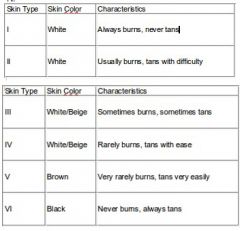
A: |
|
|
Glogau Photoaging Classification? |

A: |
|
|
Twelve factors affecting Chemical Peel penetration |
A: Skin Stratum Corneum thickness – can be thinned by retinoids, α-hydroxy acids; Tretinoin (retinoic acid) thickens epidermis, thins stratum corneum, reverses keratinocyte atypia A: Pilosebaceous gland activity & density – can be minimized using degreasing agents A: Prepeel degree of Abraision, use of Keratolytics (retinoids, α- hydroxy acids), Degreasing agents A: Agent, Concentration, and Amount used A: Application pressure, number of layers, and timing A: Occlusion/semiocclusion – Increases penetration 3: Classified by layer of penetration – To Stratum Corneum or Basale of Epidermis, Papillary Dermis, Papillary-Reticular junction, Reticular dermis |
|
|
Four parts to Pilosebaceous unit (HESS) |
A: Hair follicle A: Errector pili muscle A: Sebaceous gland A: Apocrine Sweat gland |
|
|
Depths of Peels and Indications |
A: Superficial – to Superficial Papillary Dermis; to Freshen appearance A: Medium – to Papillary-Reticular junction; for patients with Actinic keratoses, moderate Rhytids, Dyschromias present in the epidermis and upper dermis A: Deep – to Midreticular Dermis; for heavy Wrinkles, Solar Lentigines, Lines secondary to photodamage, superficial Premalignant Keratoses |
|
|
Types of chemical Peeling agents |
A: Glycolic acid – sugarcane derived α-Hydroxy Acid, 20-70% concentrations, Superficial peeling agent; penetration dependent upon skin contact A: Trichloroacetic Acid (TCA) – Coagulates protein in skin, neutralized by serum, less hypopigmentation, no cardiotoxic effects; 10-20% Superficial, 30-40% Medium, 45-50% Deep; should never use >35% A: Jessner – Salicylic acid, Lactic acid, Resorcinol, 14 g of each in 100 cc Ethanol; “Sally Lacks Eternal Resources” A: Brody – Combination TCA 35% and Solid CO2; Medium peeling agent A: Monheit – Combination TCA 35% and Jessner; Medium peeling agent A: Coleman – Combination TCA 35% and Glycolic acid 70%; Medium peeling agent A: Phenol peels – Deep peel, causes pigmentation changes A: Baker-Gordon – Phenol, Tap water, Croton oil, Septisol; Deep peeling agent, requires anesthesia, IV fluids and monitoring; “Penny Taps Crusty Skeptics” |
|
|
Give examples of Pre-treatment, Very superficial, Superficial, Medium and Deep Peels |
A: Pre-treatment – Tretinoin A: Very superficial – TCA 10% (1 coat) A: Superficial – TCA 10-35% (1 coat) A: Medium – TCA 35% with Jessner’s solution (Monheit) A: Deep – Baker-Gordon Phenol formula |
|
|
Six indications for chemical Peels |
A: Aging – Fine rhytids A: Actinic damage – Keratosis, Lentigines A: Other skin lesions – Premalignant keratosis, superficial BCCs, Epidermal growths A: Acne management A: Scars – Superficial and Acne A: Pigment changes – Melasma/Chloasma, Frekles 3: “Aging Actors Often Are Scarry Pigs” |
|
|
Five Absolute contraindications to chemical Peels |
|
|
|
Eight Relative contraindications to chemical Peels |
A: Medication use – Estrogen, warfarins A: HIV – With low CD4 count A: Accutane – 1 to 2 years must elapse before using a deep peel A: Telangiectasias – Become more prominent after peel A: Radiotherapy to face A: Keloid former A: Dark skin – Fitzpatrick types IV to VI A: Previous face lift or blepharoplasty A: Latent Herpes simplex 3: “Mehdi Had A Truly Rare Komplication of Deep Peels: Herpes” 3: Brody’s Relative contraindications: Darker skin type, such as Fitzpatrick IV, V, and VI Keloid formation History of herpes infection Cardiac abnormalities History of previous facial irradiation Marked amount of vellus hairs present Unrealistic patient expectations Physical inability to properly care for the face postoperatively Telangiectases Anticipation of inadequate photo protection because of job, vocation, or recreation |
|
|
Nine complications of chemical Peels & Dermabrasion |
A: Persistent erythema A: Pigment abnormalities A: Increased sun sensitivity A: Dermatitis A: Full thickness skin loss A: Hypertrophic scar A: Foreign body granulomaA: Milia A: HSV reactivation or dissemination |
|
|
Sunlight & photoaging |
A: UVB = 290-320 nm; causes sunburn & skin cancer A: UVA = 320-400 nm; passes through window glass, constant intensity through year, 90% of solar radiation reaching surface; Deeper penetration into dermis, causes photoaging (breaks down collagen & elastin, damages superficial blood vessels, immune suppression, increases cancer stimulating effects of UVB, role in melanoma formation) |
|
|
Sunscreens |
A: Organic – UV filters secondary to conjugate double bonds A: Physical – Reflect & scatter light (eg. zinc oxide) 3: SPF# – Derived from testing under artificial light, for UVB only |
|
|
Nine Telangiectasia associations |
A: Radiation dermatitis A: Carcinoid A: Chronic alcoholism A: Liver disease A: Pregnancy A: Childhood A: Dermatomyositis A: Scleroderma/CREST A: Osler-Weber-Rendu |
|
|
Stuff about hair, number, and hormonal influences? |
A: 100,000 hairs on the head A: Testosterone influences axillary & pubic hair growth A: Dihydro-Testosterone (DHT) influences beard growth and pattern baldness |
|
|
Phases and lengths of Hair Growth cycles (ACT) |
A: Total length ~1000 days A: Anagen phase – 90%, Active phase, ~3 years A: Catagen phase – Slow growth A: Telogen phase – 10%, Resting phase, ~3 months |
|
|
What is Norwood’s Classification? |
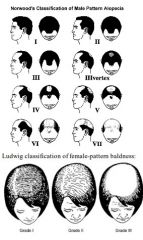
A: Norwood 1 = Normal A: Norwood 2 = Small triangular Frontotemporal recession A: Norwood 3 = Moderate triangular Frontotemporal recession, add “vertex” if Vertex hair loss A: Norwood 4 = Severe triangular Frontotemporal recession with Vertex hair loss A: Norwood 5 = Only a thin band of hair between Frontotemporal and Vertex hair loss A: Norwood 6 = No separation between Frontotemporal and Vertex hair loss A: Norwood 7 = Only little hair left in Occipital area between the ears |
|
|
Etiology of Alopecia |
A: Autoimmune disease A: Burns A: Chemotherapy A: Dermatologic disorders (eg. psoriasis) A: Exposure to Radiation A: Male pattern baldness A: Neoplasms A: Pulling/Traction 3: “ABCDE…My Nogin Please!” |
|
|
Five types of Alopecia |
A: Androgenic alopecia A: Alopecia Areata A: Cicatricial alopecia A: Traumatic alopecia A: Diffuse alopecia |
|
|
Management of Alopecia |
A: Medical (RMT-PFO) Rogaine (Minoxidil) – Topical; local vasodilator, potassium-like agonist that reduces cytoplasmic free calcium Propecia (Finasteride) – Oral; 5α-reductase inhibitor A: Hair bearing Autografts – Minimum age is 26, ideal age is 40; Follicular unit grafts Micrografts – 1-2 hairs Minigrafts – 3-6 hairs Standard grafts – >7 hairs, punch or strip grafts A: Scalp reduction – Removes an average 3-5 cm of scalp Straight vertical Mercedes-shaped – Bilateral OccipitoParietal +/- OccipitoTemporal flaps Marzola-shaped – Along OccipitoParietal hair border A: Pedicled flaps – Juri’s delayed Temporo-Parieto-Occipital flap, based on Superficial Temporal artery, uni or bilateral; can also do Lateral, or Preauricular flaps A: Tissue expansion – Takes 2-3 months, start injections at 2-3 weeks, repeat injections every 2-3 days A: Any Combination of above |
|
|
Four types of Scalp flaps for Alopecia |
A: Lateral A: Temporoparietal occipital (Juri) A: Preauricular A: Free flap |
|
|
Four types of hair grafting techniques |
A: Follicular Unit transplantation A: Micro graft – 1-2 hairs A: Mini graft – 3-6 hairs A: Punch graft A: Strip graft |
|
|
How long to wait for recovery potential of VII before reanimation and what is maximum length of time post injury for restoration of neural input |
A: Wait 1 year for recovery A: Wait 3 years max for reinnervation |
|
|
Rank best procedures for outcome of Facial Nerve Reanimation |
A: Best – One which restores neural input (ie distal facial nerve available), such as direct anastomosis, cable graft, or nerve crossover A: 2nd – Replace nonfunctional facial neuromuscular units (regional or free muscle transfer) A: 3rd – Statically resuspend facial tissues |
|
|
Five functional defects of Facial Nerve paralysis |
A: Lagopthalmos and ectropion A: Nasal obstruction A: Oral incompetence A: Mastication difficultiesA: Articulation difficulties |
|
|
Goals of surgery |
A: Functional – Eye protection, Oral competence A: Cosmetic – Symmetry, Volitional facial expressions |
|
|
Classification of facial nerve rehabilitation procedures |
A: Restore Neural input (Dynamic) Direct reanastamosis Cable graft Nerve crossover technique (XI, XII) Cross facial Nerve grafting technique A: Replace nonfunctional facial Neuromuscular units (Dynamic) Regional (Temporalis, Masseter) Microvascular with facial nerve crossover (Extensor digitorum brevis, Gracilis, Lat dorsi, Pec major) A: Static resuspension facial tissues (with tensa fascia lata, goretex, or alloderm) Elevation of oral commissure Elevation of ptotic brow A: Addressing Specific defects Gold weight implant Palpebral springs and silastic slings Wedge resection and lateral canthoplasty (for ectropion) Temporal fascia sling repair of ectropion Tarsorrhaphy (with or without lateral lid adhesion, 5-6 mm) Formal brow lift (Direct, Mid forehead, Pretricheal, etc.) Rhytidectomy with SMAS plication Lower lip wedge resection with transposition of orbicularis oris Botox injection for synkinesis or hypertonia |
|
|
Four factors important in the Treatment algorithm for facial nerve paralysis reamination |
A: Duration since Facial nerve injury – More or less than 3 years A: Health and Prognosis of Patient A: Presence of Distal Facial nerve A: Presence of Proximal Facial nerve |
|
|
Treatment algorithm for facial nerve paralysis reamination withDuration since facial nerve injury >3 years |
A: Unhealthy patient, poor prognosis – Static resuspension A: Healthy patient – Regional/free muscle transfer |
|
|
Treatment algorithm for facial nerve paralysis reamination with Duration since facial nerve injury <3 years |
A: Unhealthy patient, Poor Prognosis – Static resuspension A: Healthy patient, Good Prognosis, and Distal Facial not present –Regional/free muscle transfer A: Healthy patient, Good Prognosis, Distal Facial present, butProximal Facial not available – Crossover or cross-facial graft A: Healthy patient, good prognosis, Distal Facial present, andProximal Facial available - End-to end anastamosis or interposition graft |
|
|
Five Indications for Muscle Transfer techniques for Facial Reanimation |
A: Long-standing paralysis (>3 years) with little chance of recovery using nerve grafting procedures A: Lack of intact facial neuromuscular units due to Fibrosis, Atrophy or Congenital absence A: Patient contraindications to nerve crossover techniques |
|
|
Define Marginal Reflex Distance |
A: Distance from corneal light reflex to the margin of the lids A: Normal upper lid distance is 4-5 mm (corresponds to upper lid just below limbus) A: Normal lower lid distance is 5 mm (corresponds to lower lid at limbus) A: Reflex to limbus is 2.5 mm above and below A: Palpebral fissure width is 10 mm |
|
|
Protractor and Retractors of upper lid |
A: Protractor – Orbicularis Oculi A: Retractor – Levator Palpebrae Superioris and Mullers muscle |
|
|
Which muscles are important in the lacrimal extretory pump |
A: Horner’s muscle (Deep head of pretarsal orbicularis oculi) A: Superficial head of the pretarsal orbicularis oculi A: Deep head of the preseptal orbiculari oculi 3: Last two are form Janfaza, p.181, and Lacrimal fascia is also included |

